How To Sell On Spotify Today: Step-by-Step Guide + Top Products
Are you ready to transform your passion into a profitable online business? Want to learn how to sell on Spotify?
Imagine turning your Spotify profile not just into a showcase for your music, but a thriving marketplace for your merchandise.
In this guide, I’ll walk you through every essential step from creating your Spotify for Artists account to linking up with Shopify and beyond.
Moreover, if you ever wondered what sells best or how to maximize your profit margins on the platform, stay tuned.
Let’s dive into the world of how to sell on Spotify, and unlock the secrets to do it the right way. Ready to amplify your artist revenue? Read on.


Table of Contents
- Key Takeaways
- How To Sell On Spotify in 2024? (My Step-by-Step Approach)
- Step 1- Create Your “Spotify For Artists” Account
- Step 2- Create a Shopify Account
- Step 3- Connect Shopify With Print On Demand Service
- Step 4 – Design Your Merchandise
- Step 5 – Add Your Products To Shopify
- Step 6- Set up Tax & Payment Methods
- Step 7- Link Shopify and Spotify
- Step 8- Add Your Products to Spotify
- EXTRA TIP: Connect Your Store To Multiple Artist Profiles
- How Much Does It Cost To Sell On Spotify With Shopify?
- The No. 1 Tool for all dropshippers – now with AI
- What Can You Sell On Spotify?
- Best Merchandise To Sell on Spotify
- Why Sell on Spotify?
- Conclusion
Key Takeaways
- Integrate Your Shopify Store with Spotify
- Start by logging into your Spotify for Artists account.
- Navigate to ‘Profile’ and then to ‘Merch’ where you will find the option to ‘Log in to Shopify’.
- Enter your Shopify store URL (like “your-store-name.myshopify.com”) and click ‘Link Shop’.
- Log into your Shopify account and follow the prompts to add Spotify as a sales channel, accept the terms, and link to the desired artist profile.
- Publish Merchandise on Spotify for Artists
- Log into your Shopify account and go to ‘Settings’.
- Select ‘Products’ and then ‘All products’. Choose a product, ensuring the description and media use plain text and static images, as videos and formatted text are not supported.
- Under Sales channels and apps’, check if Spotify is selected and then click ‘Done’.
- Save your changes at the top of the product page.
- Add Merchandise to Your Spotify Artist Profile
- Access your Spotify for Artists dashboard and go to ‘Profile’ followed by ‘Merch’.
- Select ‘Add to shop’ next to the merchandise items you wish to display on your profile.
How To Sell On Spotify in 2024? (My Step-by-Step Approach)
Spotify has recently launched its integration with Shopify. So, its users, and artists can now sell merchandise as well. As I have personally tried this feature, I must say I am amazed.
And, Spotify really helped me build my customer base.
So, I will show you what exactly you need to do to sell on this huge platform.
Step 1- Create Your “Spotify For Artists” Account
If you want to sell on Spotify, you must have a “Spotify for Artists” account.

So, to create an account on Spotify for Artists, you’ll need a regular Spotify account to sign in.
Once you have that, access the Spotify for Artists website and click on the “Claim Your Profile” button.
You will then be prompted to search for your artist profile if your music is already on Spotify, or you will need to provide your details if your music is about to be released.
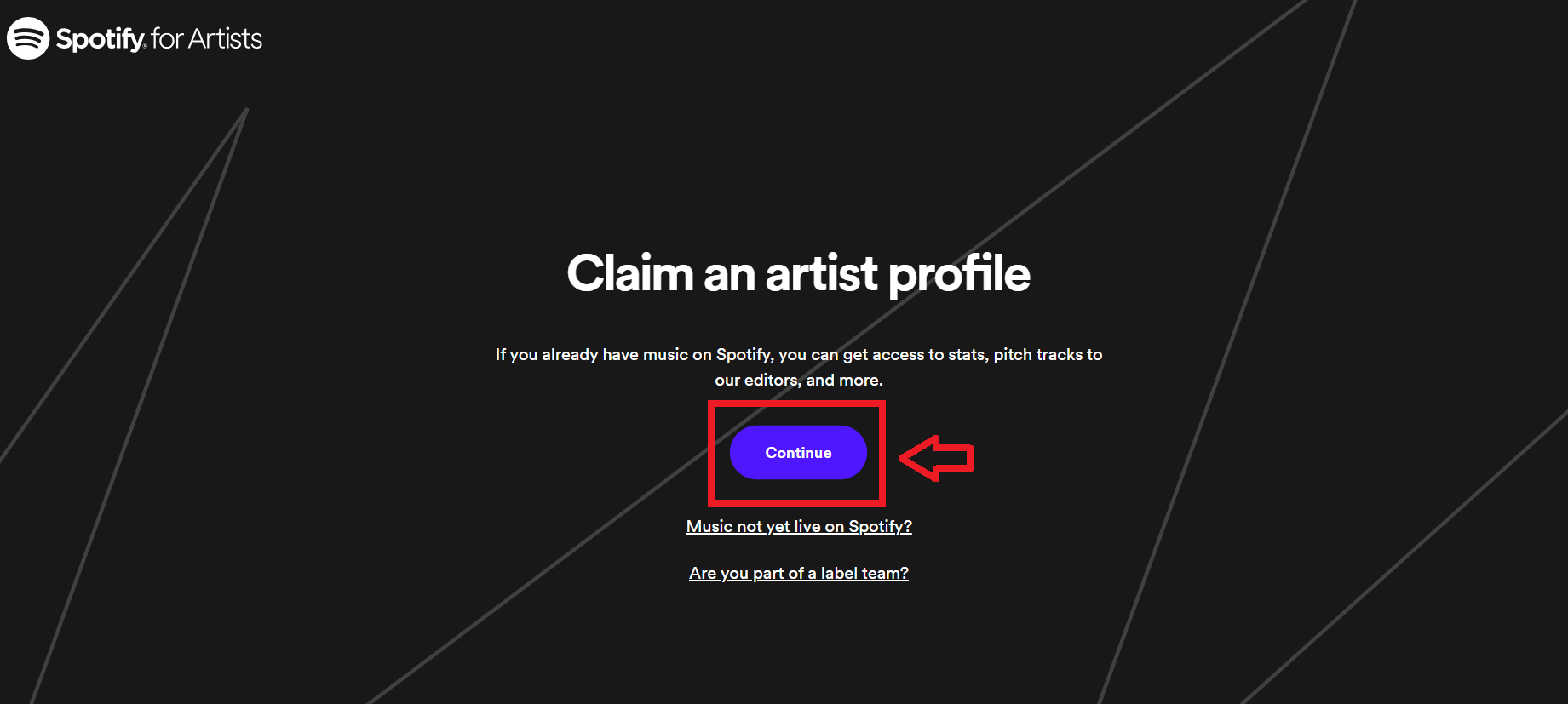
Verification may be required to confirm your identity or your relationship to the artist, potentially involving linking your social media accounts or submitting additional information.
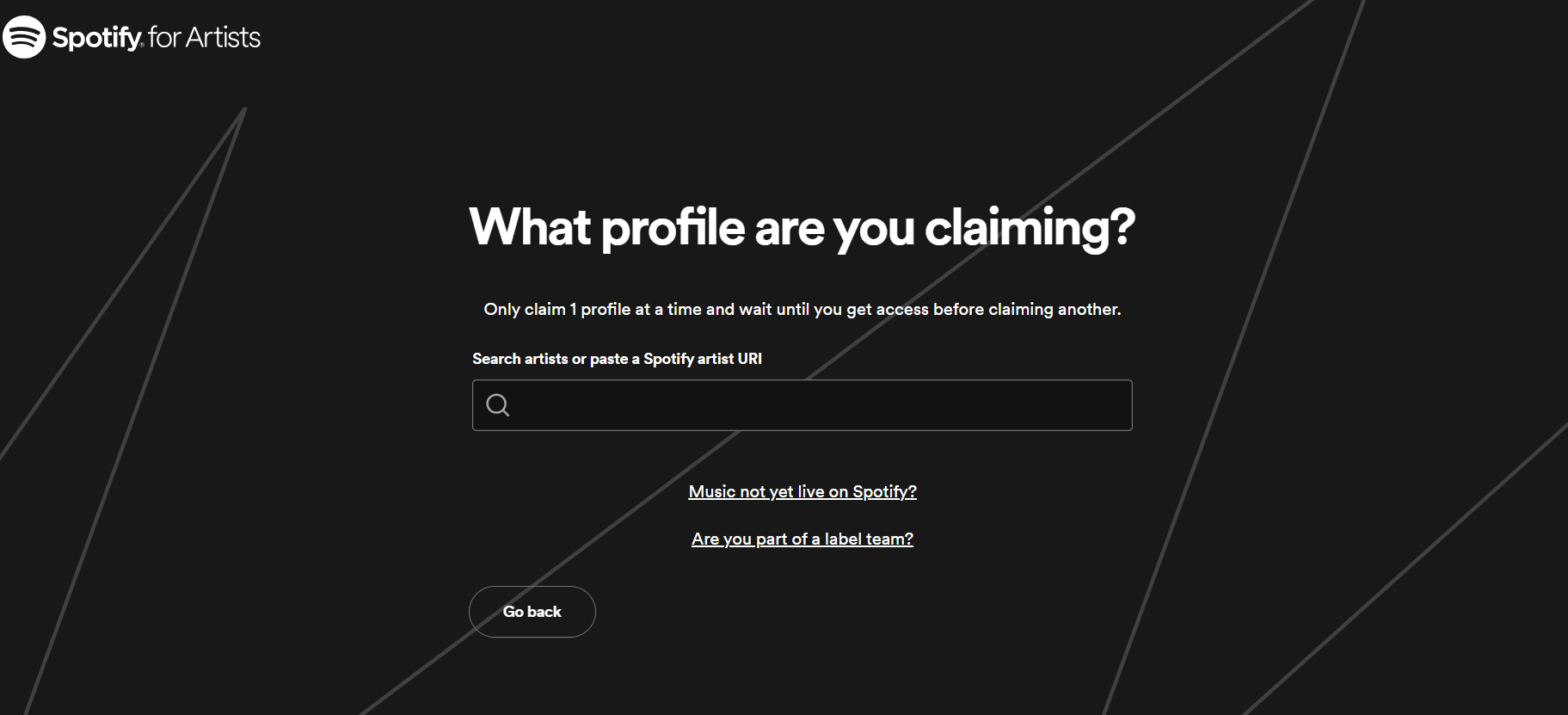
Once verified, you can set up your profile and start using all the features available in Spotify for Artists.
This comprehensive suite of tools enables effective management, promotional strategy development, and audience engagement for artists on Spotify.
Step 2- Create a Shopify Account
To start selling on Spotify, you’ll need to sign up for a Shopify account. Shopify is known for its ease of use, and getting started is quite simple.
First, head over to the Shopify website and select ‘Start free trial.’ This gives you a chance to try the platform at a minimal cost of $1 per month for the first three months.
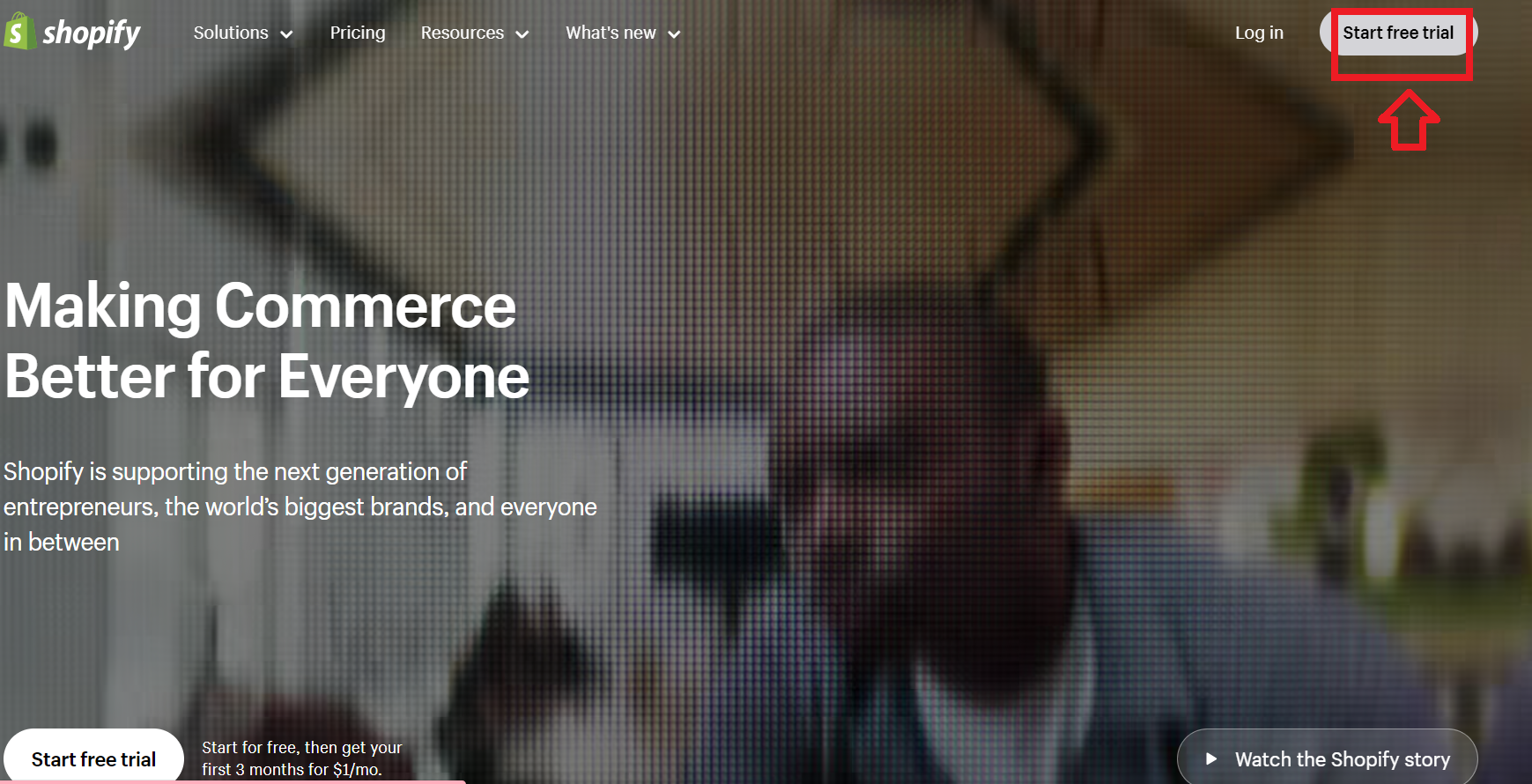
After exploring the features, you can pick a subscription plan. For those focusing on selling merchandise directly on Spotify, the Shopify Starter plan is ideal.
It allows you to sell your products on Spotify without the need to build a complete online store.
However, in this article, I will focus on how to sell on Spotify. But, if you want to know how to build a Shopify store, you can learn in my step-by-step guide.

However, I must pinpoint that I personally used the DSCOM feature of the AI-generated Shopify store. Thus, for $1 the team built me a stunning fitness dropshipping store.
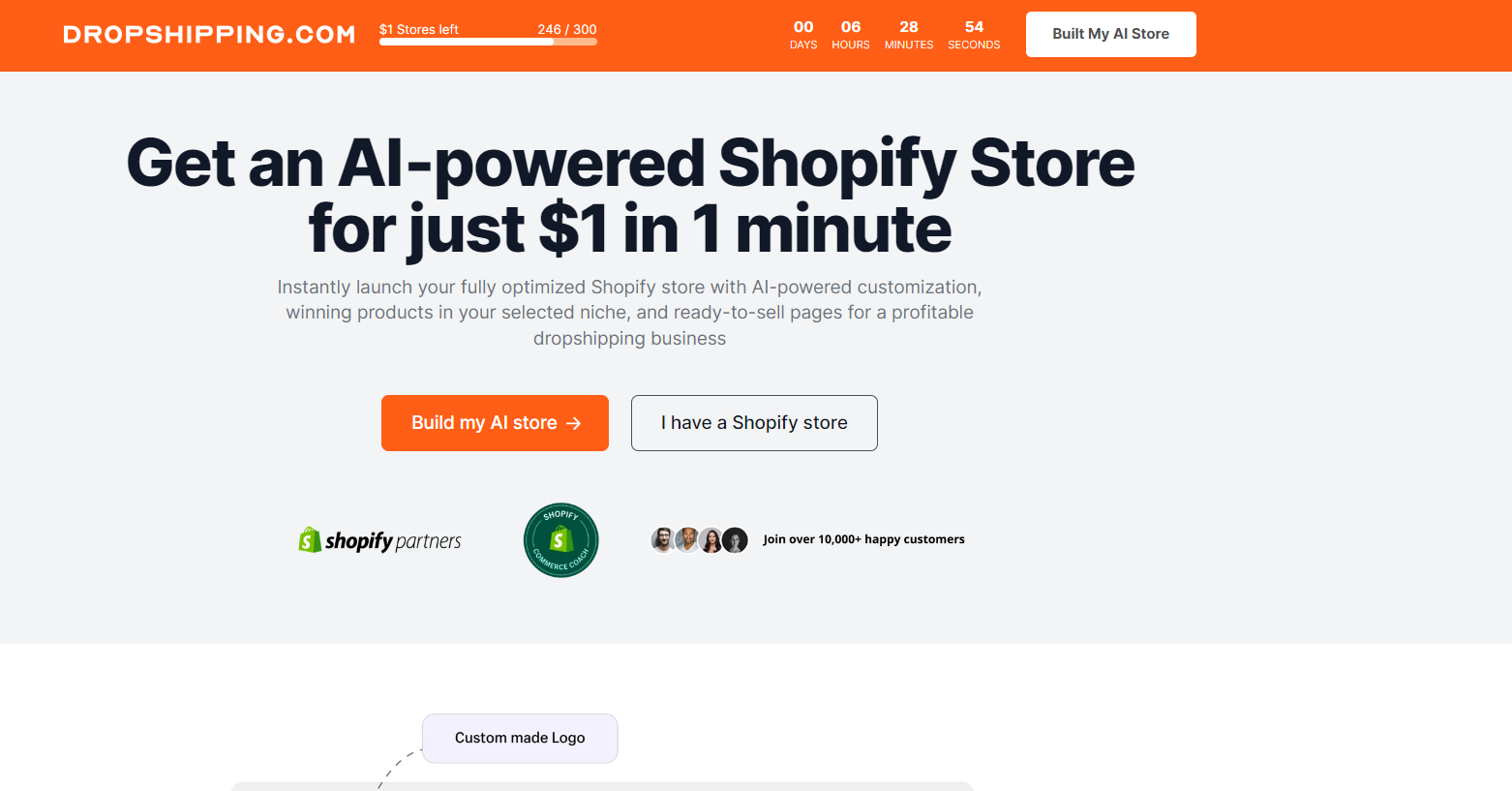
Step 3- Connect Shopify With Print On Demand Service
If you’re looking to sell your own merchandise online, consider using print-on-demand (POD) services. There are several POD companies out there, including Printify, Printful, Apliiq, and Zazzle, among others.
I personally find Printful the most affordable and suitable for my dropshipping needs, so I’ll guide you through how to connect Shopify with Printful.
First, sign up with Printful for free. This service offers a wide selection of over 300 high-quality custom products.
Next, head over to the Shopify app store and install the Printful app.
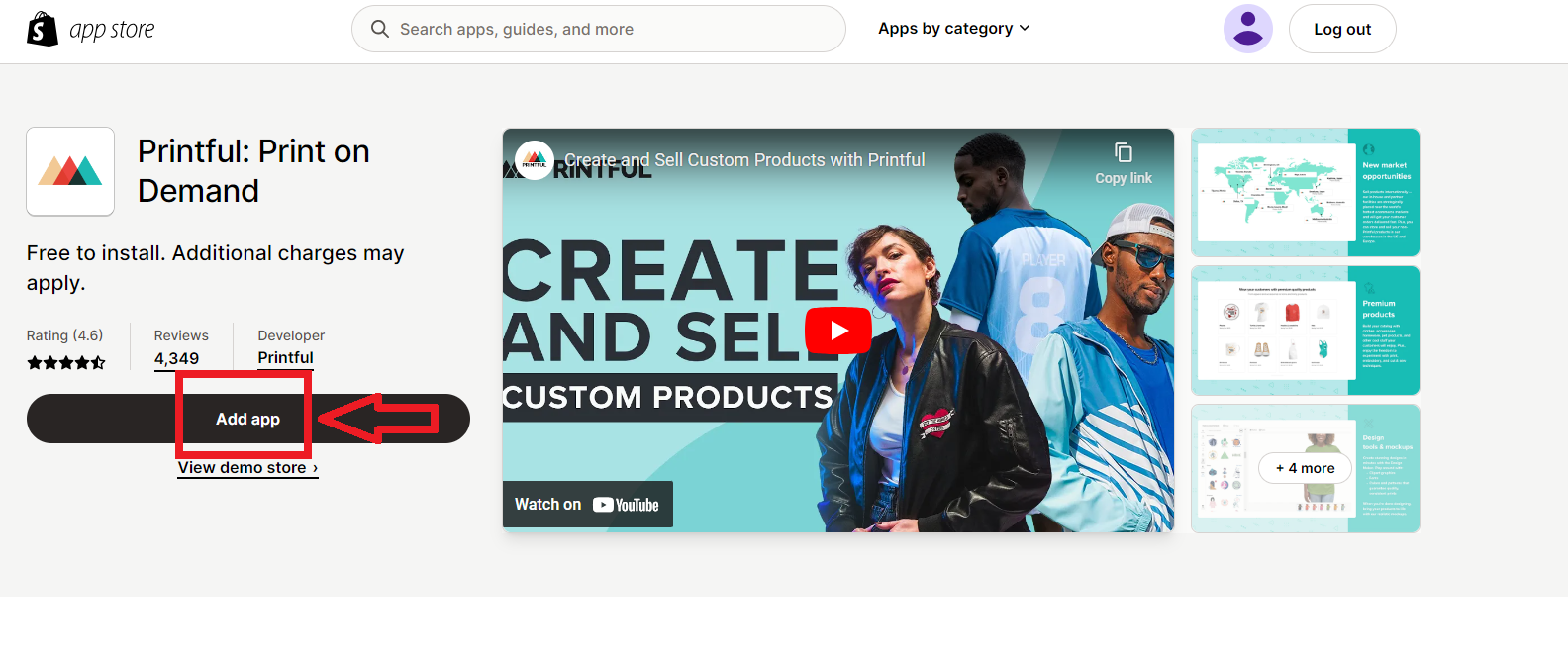
Once installed, you’re all set to start designing your merchandise right away.
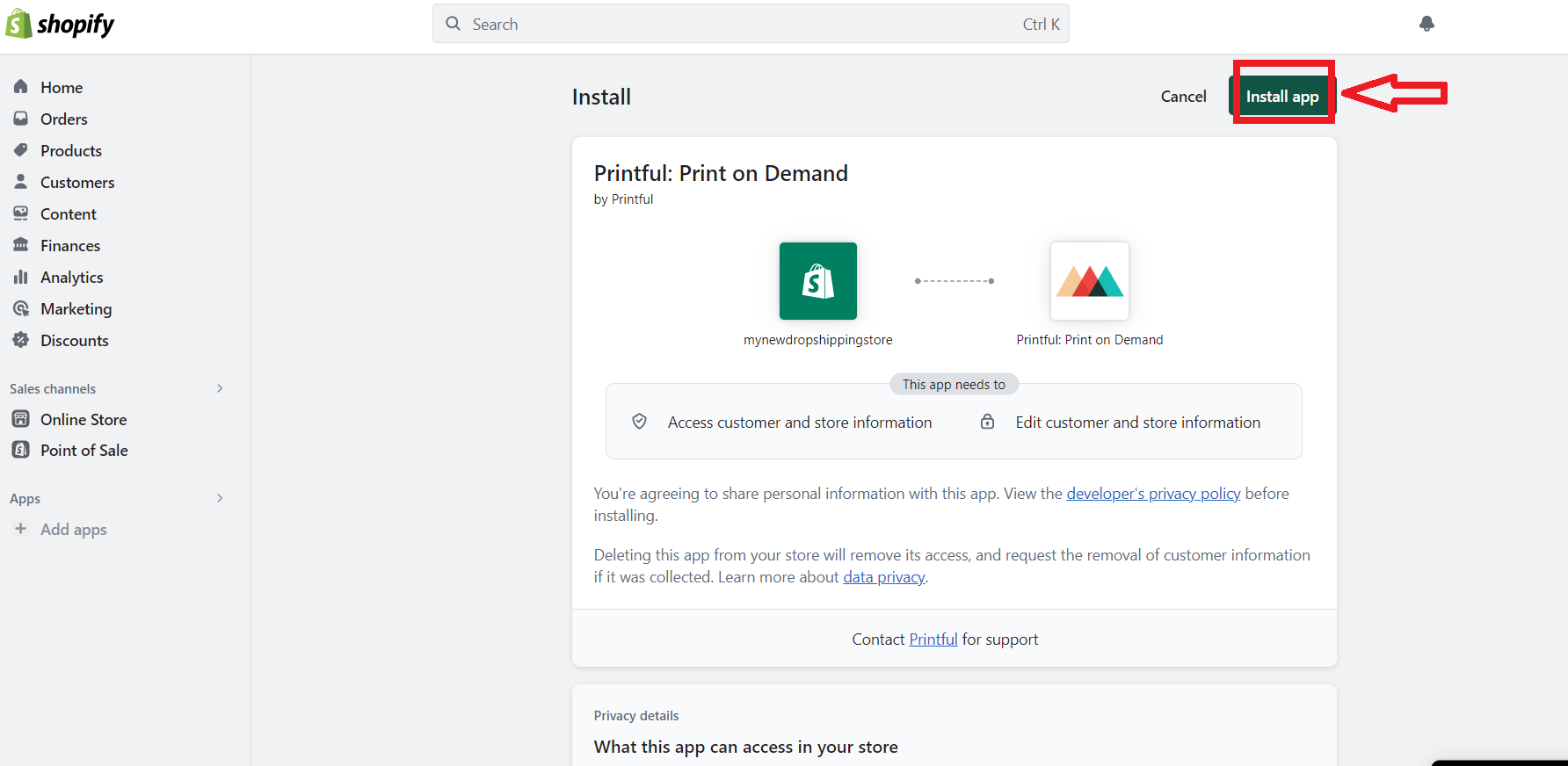
Step 4 – Design Your Merchandise
Next, using the Printful Mockup Generator is really easy—all you do is handle it through the Printful dashboard.
To get started, pick a product you want to design from Printful’s wide range of items.
So, visit the Printful Product catalog to pick out the merchandise you want to customize and sell. They offer a vast selection of items such as t-shirts, hoodies, bags, caps, shoes, and much more.
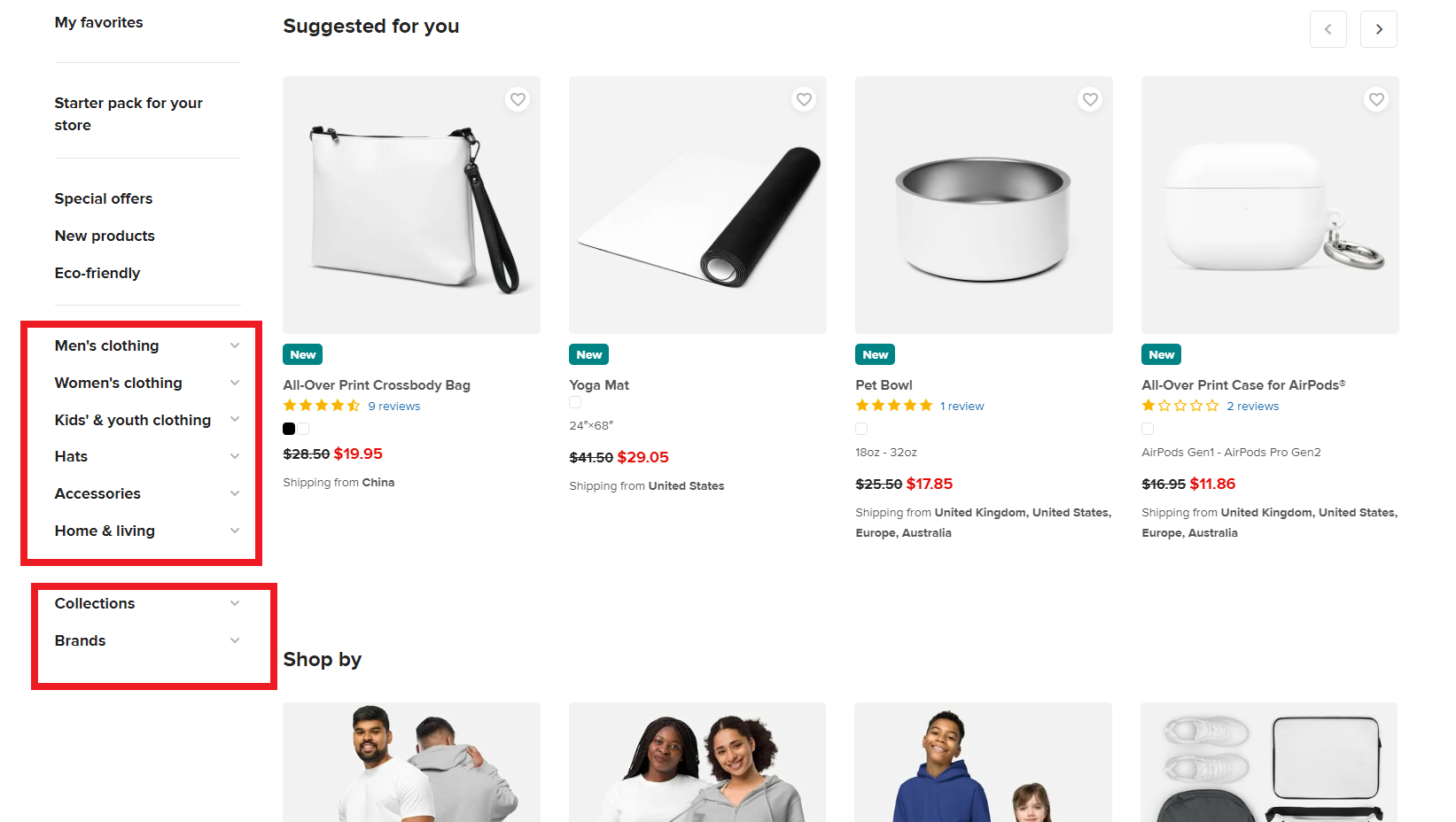
Once you select your item, you’ll be taken to the mockup generator page.
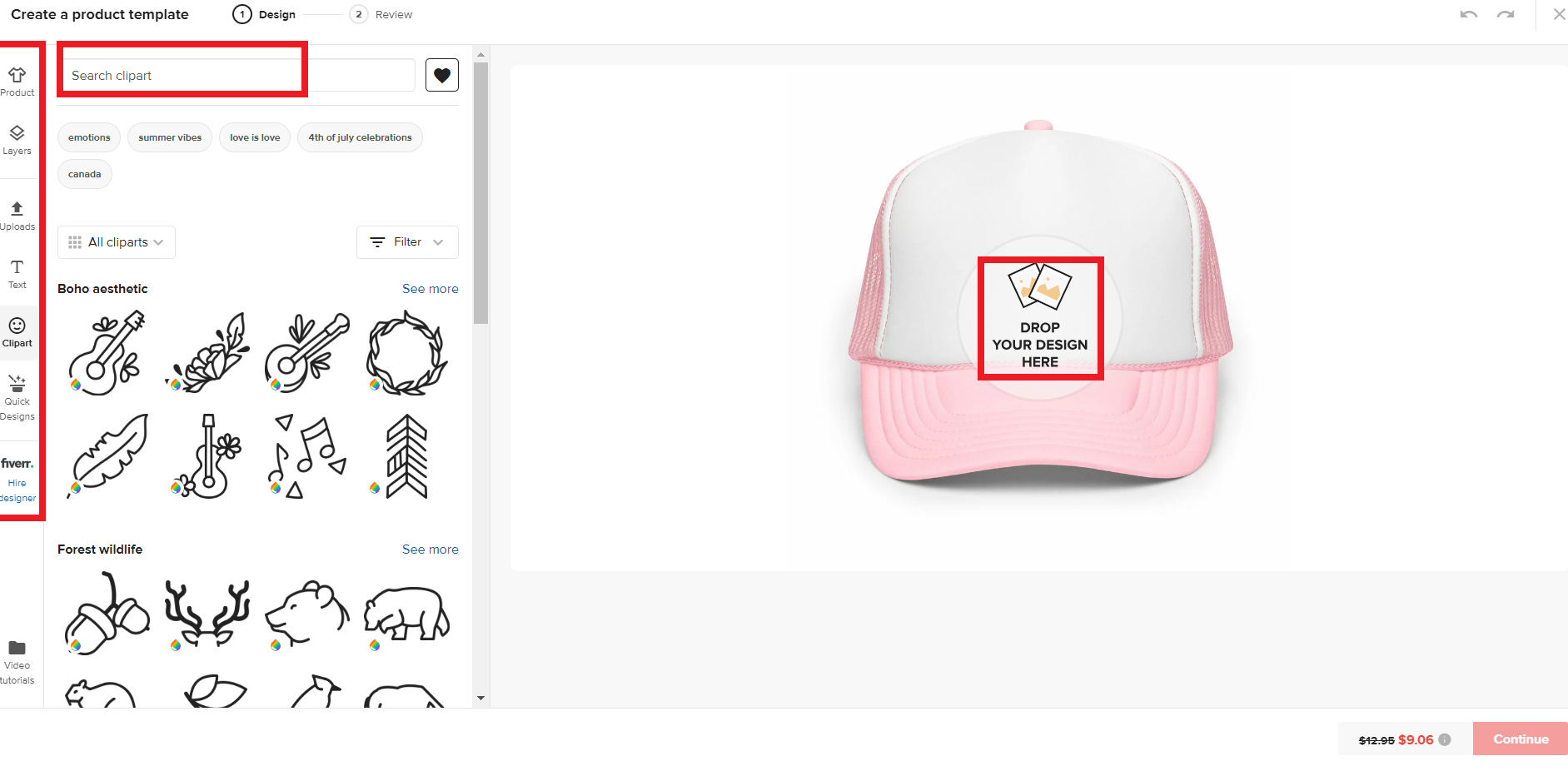
On this page, you can begin to create your design. You can add text, graphics, and quotes, and choose colors to make the product uniquely yours.
This tool is great because it lets you customize the product exactly how you want it. You can also check out the print quality and see how your branding will look on the item.
Plus, it gives you a peek at what the final product will look like before it’s actually printed.
Step 5 – Add Your Products To Shopify
Once your design is finished, you need to choose a title, description, and price for your listing. Then, add the product to your Shopify store.
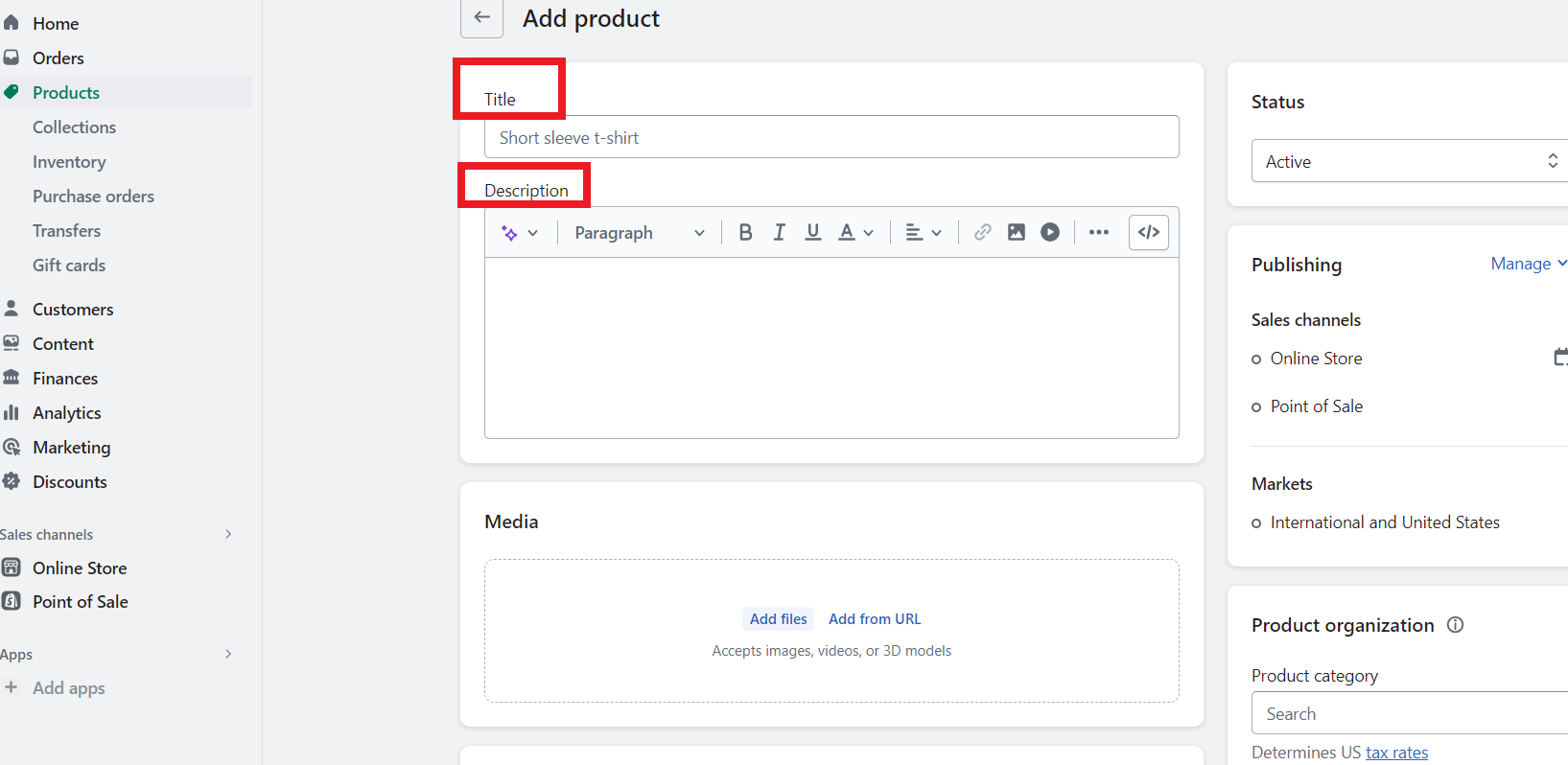
This setup ensures that when someone buys from your Shopify store, the order goes straight to Printful automatically.
Also, remember to use simple text and still images for the product description and visuals, because Spotify doesn’t support video or formatted text.
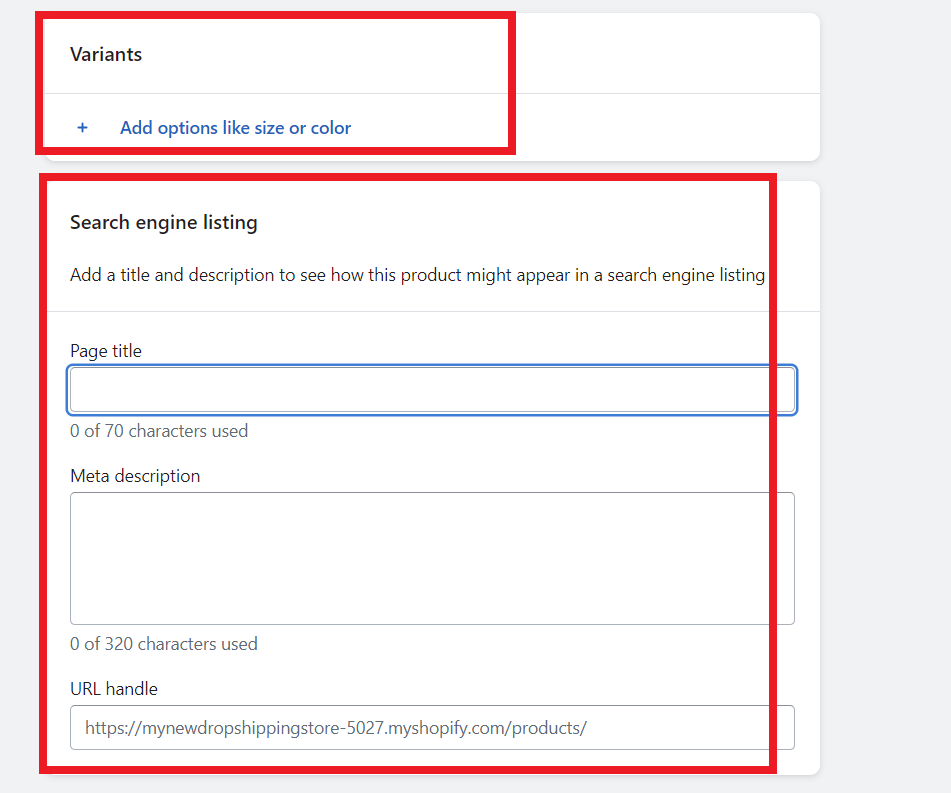
Step 6- Set up Tax & Payment Methods
When you sell on Spotify, you have to pay sales tax on your products, depending on where you’re selling to. To manage this, go into your Shopify Settings and click on ‘Taxes‘ to adjust the regions according to your location.
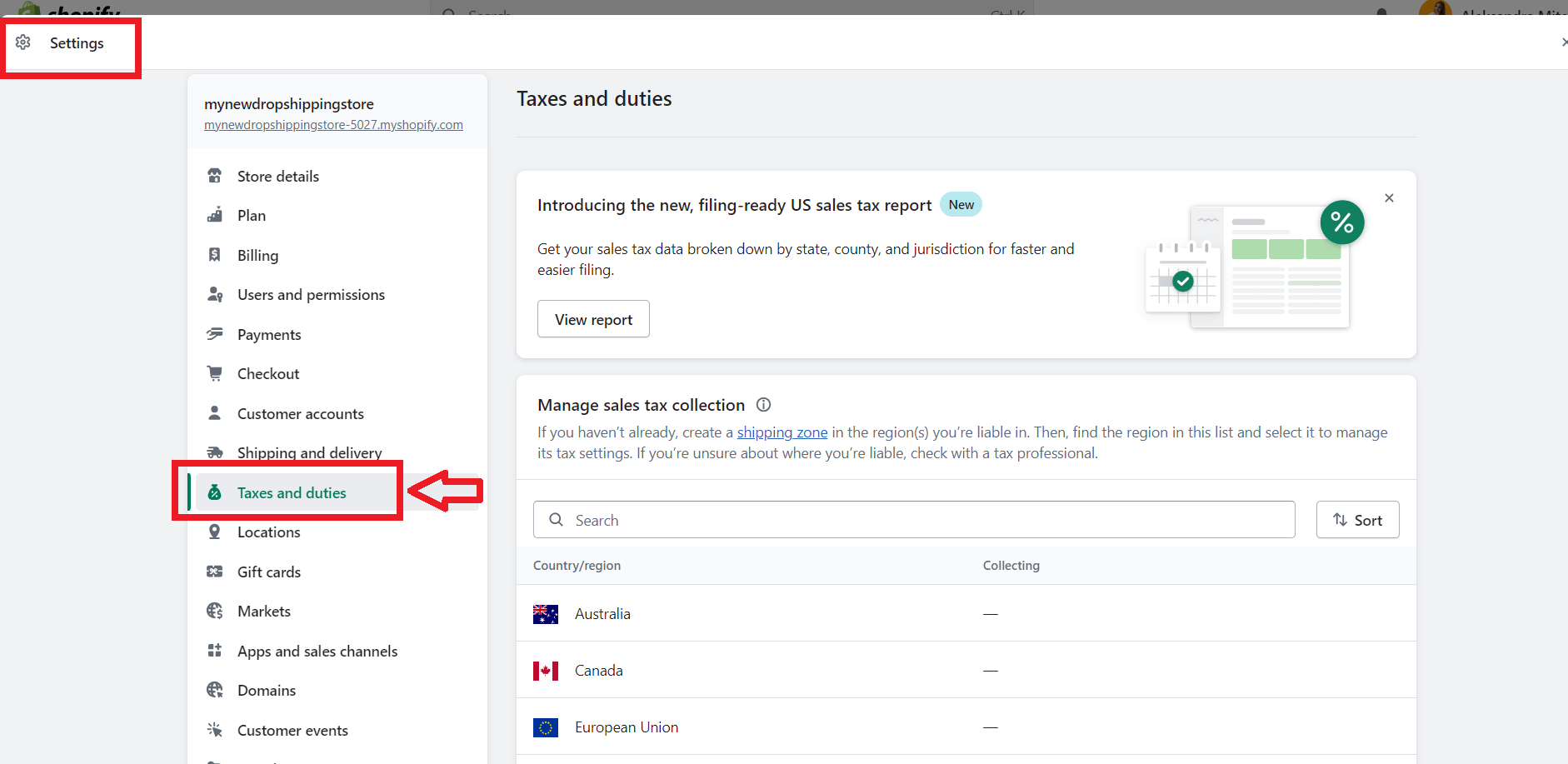
Also, make sure your customers can pay you by setting up your payment methods. Do this by going to Settings > Payments in Shopify. This step ensures that all transactions can be processed smoothly.
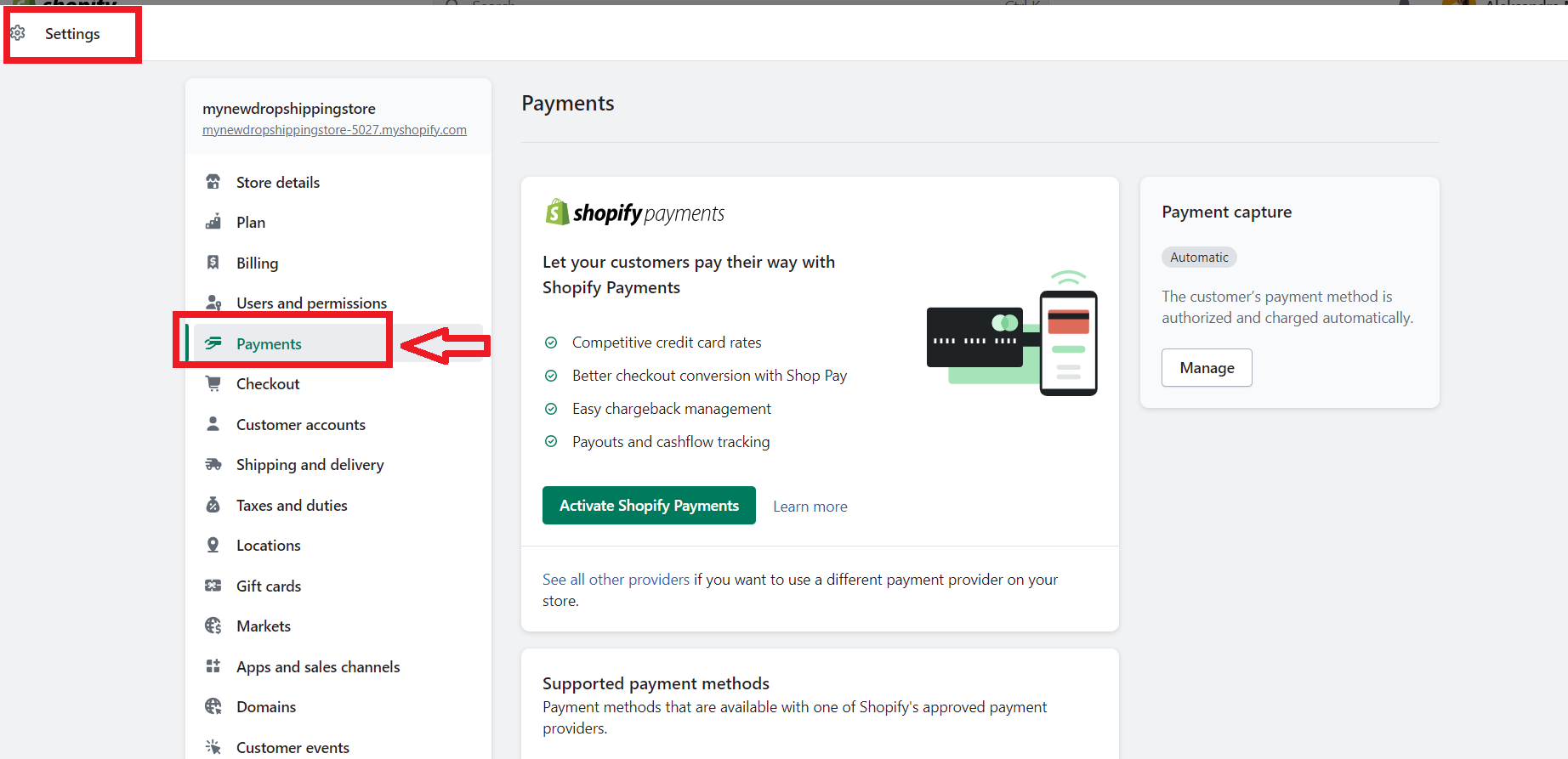
Step 7- Link Shopify and Spotify
Now that you have a functional Shopify store and some great merch designs, it’s time to add them to your Spotify artist profile.
Here’s what you need to do:
First, head over to your Spotify artist profile and find the Merch tab on your Spotify for Artists dashboard.
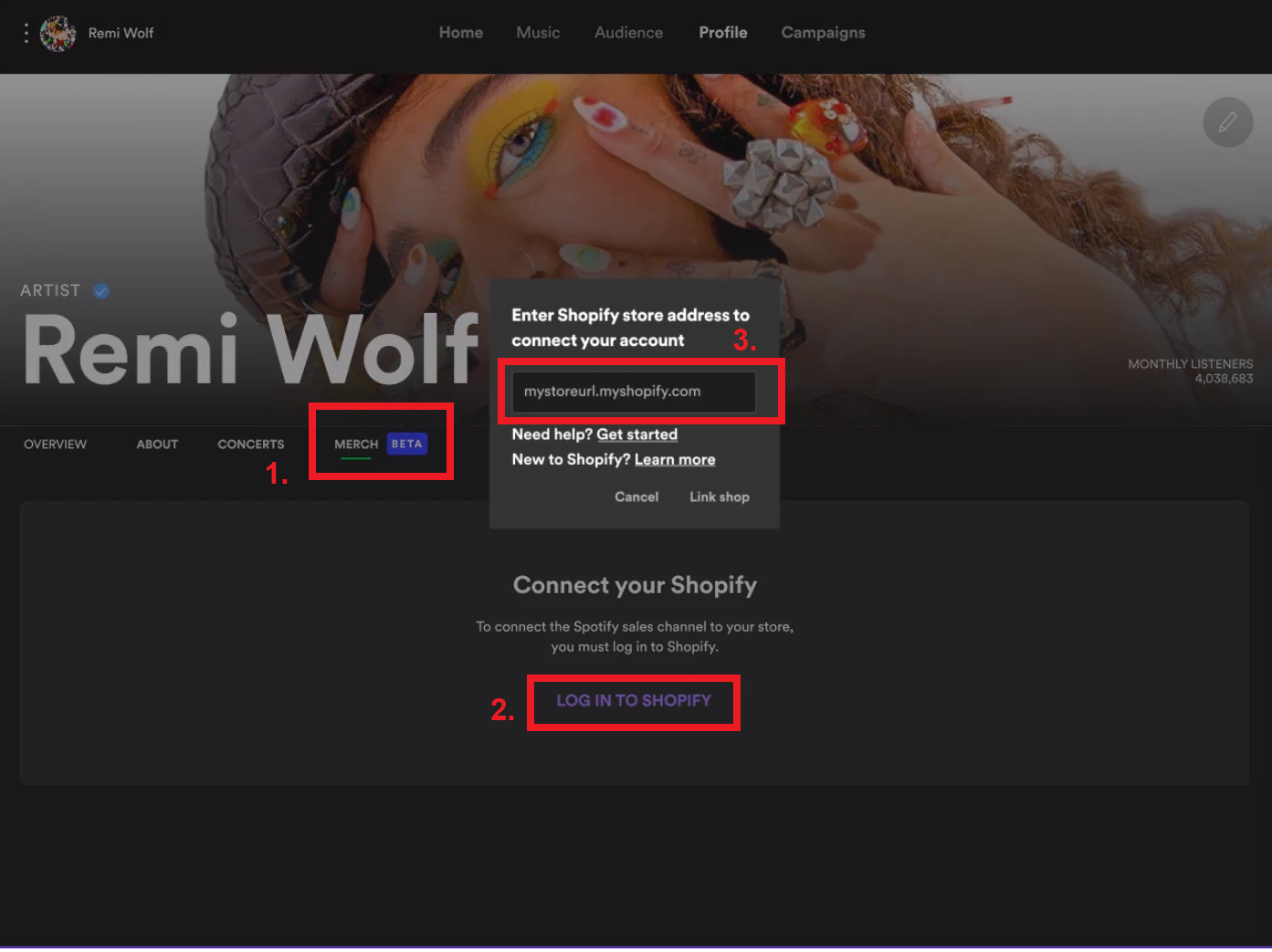
There, click on ‘Log In To Shopify.’ You’ll be asked to enter your Shopify store URL and click ‘Link Shop.’
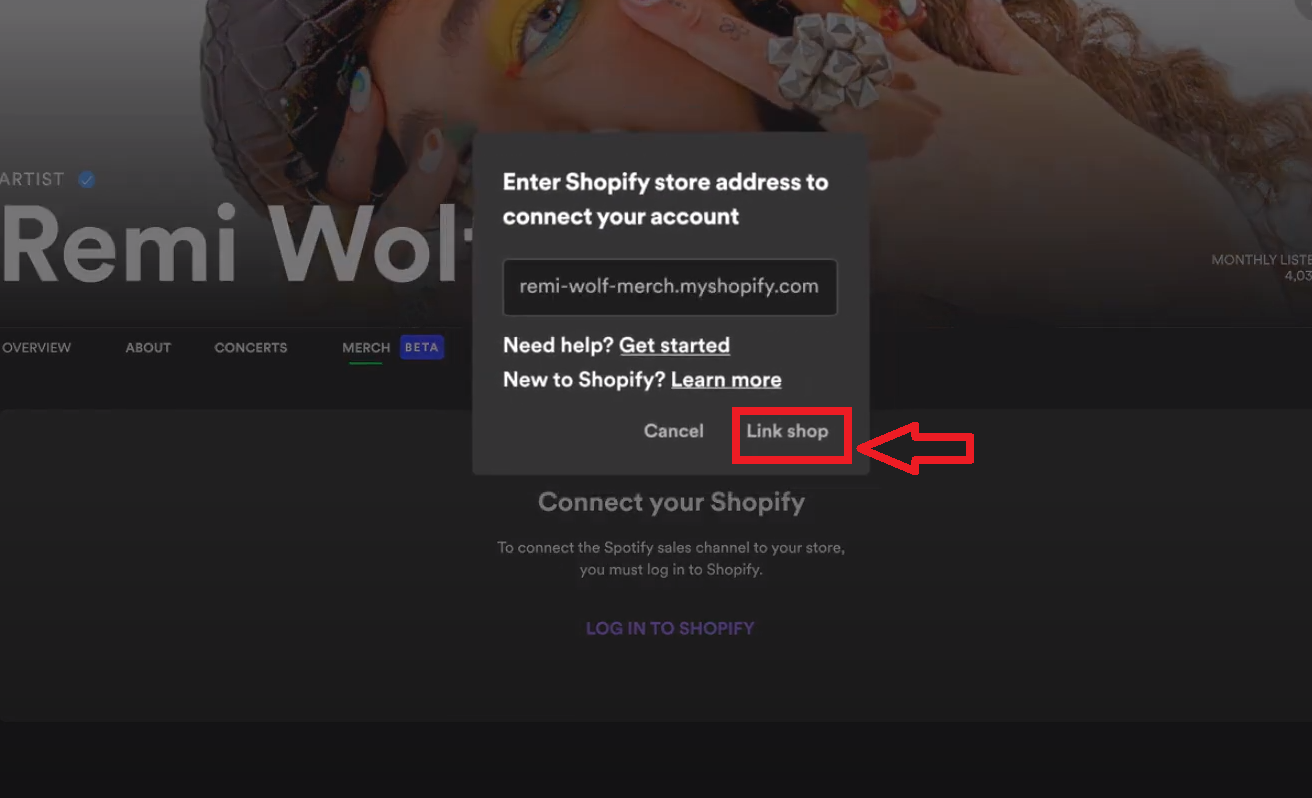
This step will prompt you to add the Spotify for Artist sales channel. Go ahead and accept the terms, and then select the artist you want to link with your shop.
Furthermore, a login popup for your Shopify account will then appear where you can enter your login details. After logging in, you’ll be prompted to ‘Add Sales Channel.’
Otherwise, you can go ti Settings>Apps and sales channels. Here, you can add the “Spotify for Artists”.
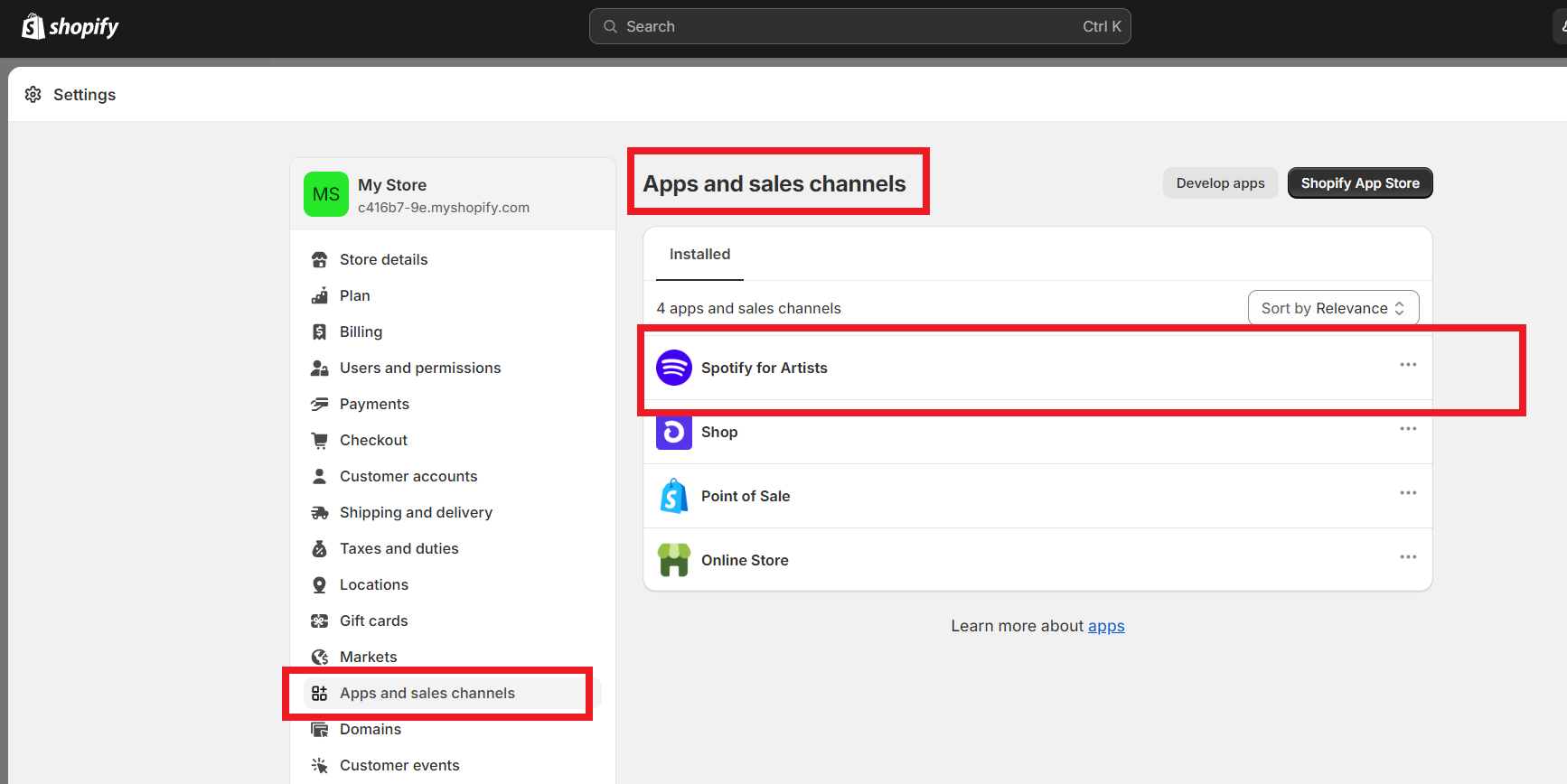
Accept the terms and conditions and then choose the Spotify artist profile that you want to link your shop to.
Once the connection is complete, you’re all set up to sell on Spotify.
Step 8- Add Your Products to Spotify
If you want to sell on Spotify, you’ll need to make it available on Spotify through your Shopify dashboard. Here’s how you can do it:
First, in your Shopify dashboard, go to the Spotify for Artists tab. At the top, you’ll find an option to Manage availability.
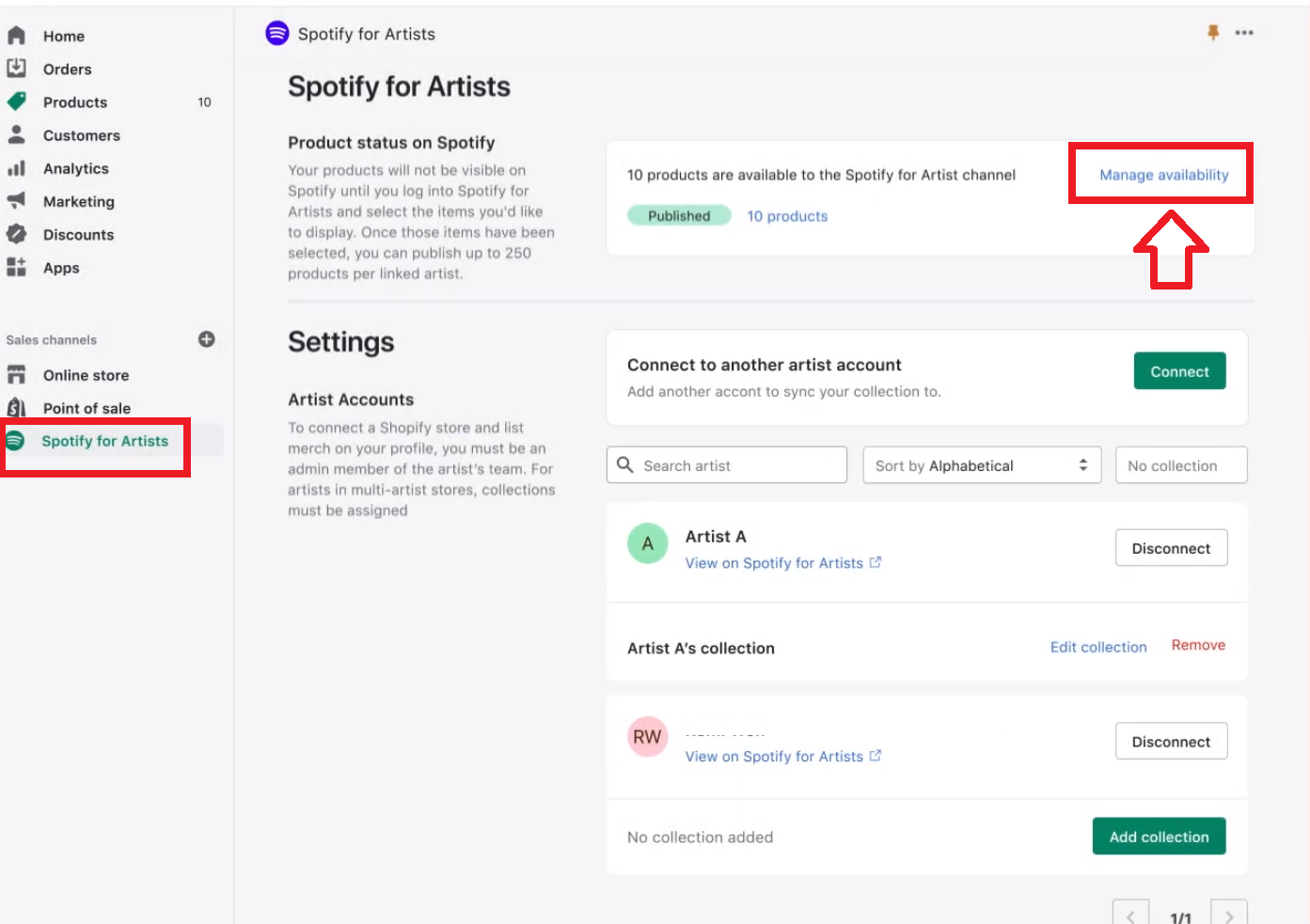
Here, you can select the products you wish to sell on Spotify and then click Save to update your settings.
Hence, you can do the same thing from the products section, by enabling the option to publish the product on “Spotify for Artists”.
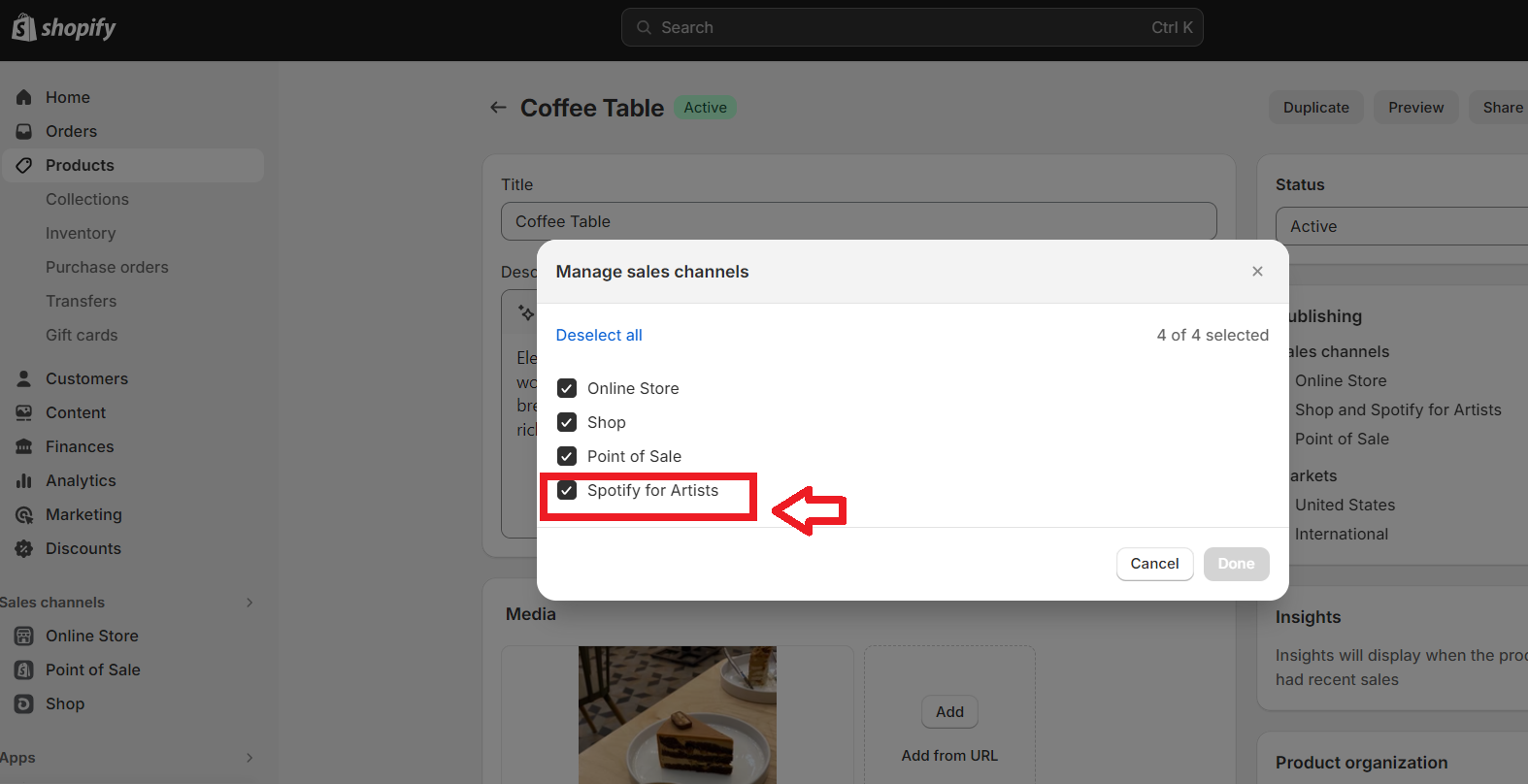
You can list up to 250 different items on your Spotify for Artists page. Additionally, you can feature up to three products directly on your Spotify Artist Profile.
Once your merchandise is published, select up to three items you’d like to highlight on your artist profile.
To do this, visit the Profile tab on Spotify for Artists, navigate to the Merch section, and then click Add to Shop under each item you choose.
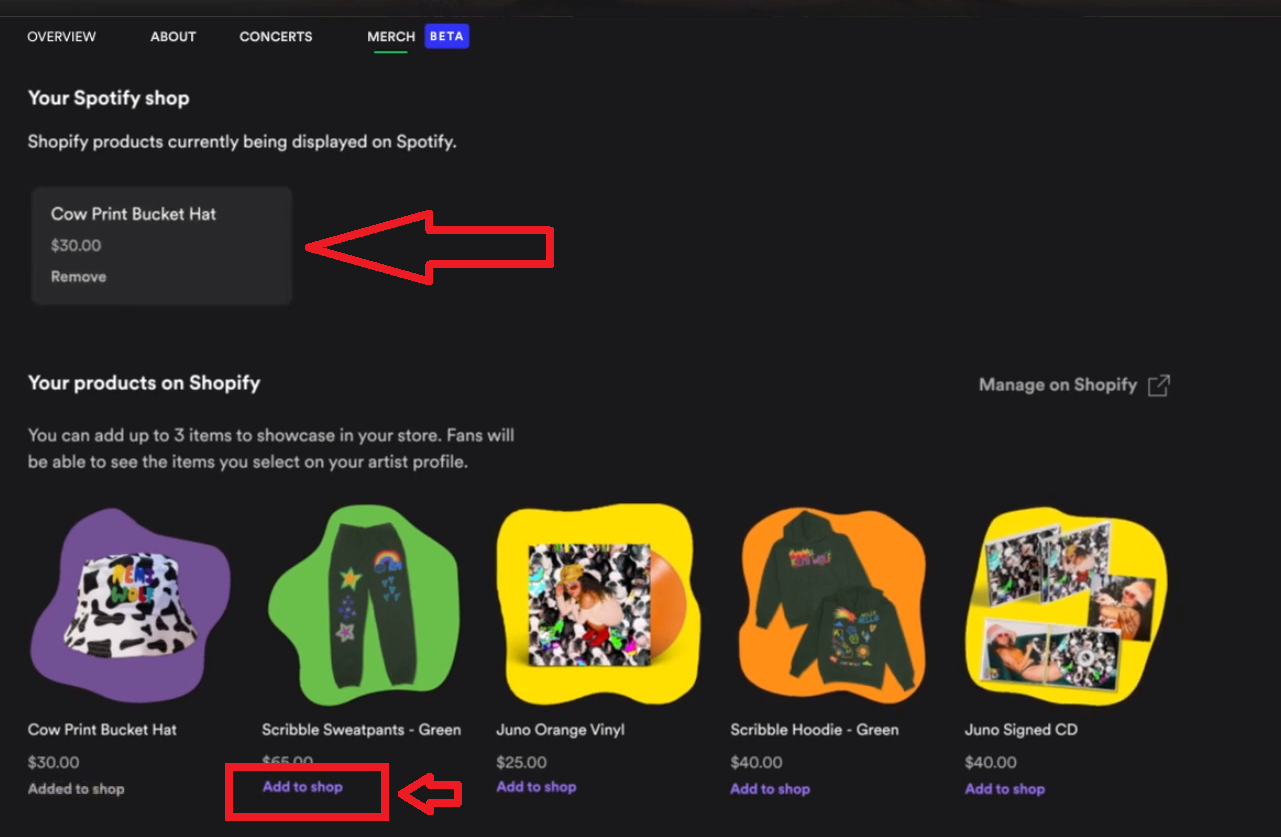
But, what if you have more than 250 products?
So, if you have more than 250 items in your Shopify store, you can manage which ones to publish on Spotify by using the Spotify Product Status card in your dashboard.
Thus, this allows you to manage availability either by individual product or in bulk.
Anytime you add new merchandise to Shopify, just repeat this process to ensure they are also available on Spotify.
The items will appear in the order you select them. If any item goes out of stock, it will automatically be removed from your profile.
You can also update, remove, or replace items at any time within Spotify for Artists to keep your store fresh and enticing, maximizing your sales potential.
EXTRA TIP: Connect Your Store To Multiple Artist Profiles
Once your account is connected, if you’re looking to link your Shopify store to multiple artist profiles, there are a few more steps you’ll need to follow to ensure the correct merchandise appears on each artist’s profile.
Start by creating a separate merchandise collection in your Shopify store for each artist. In your Shopify admin, head to Products, then to Collections, and click on Create Collection.
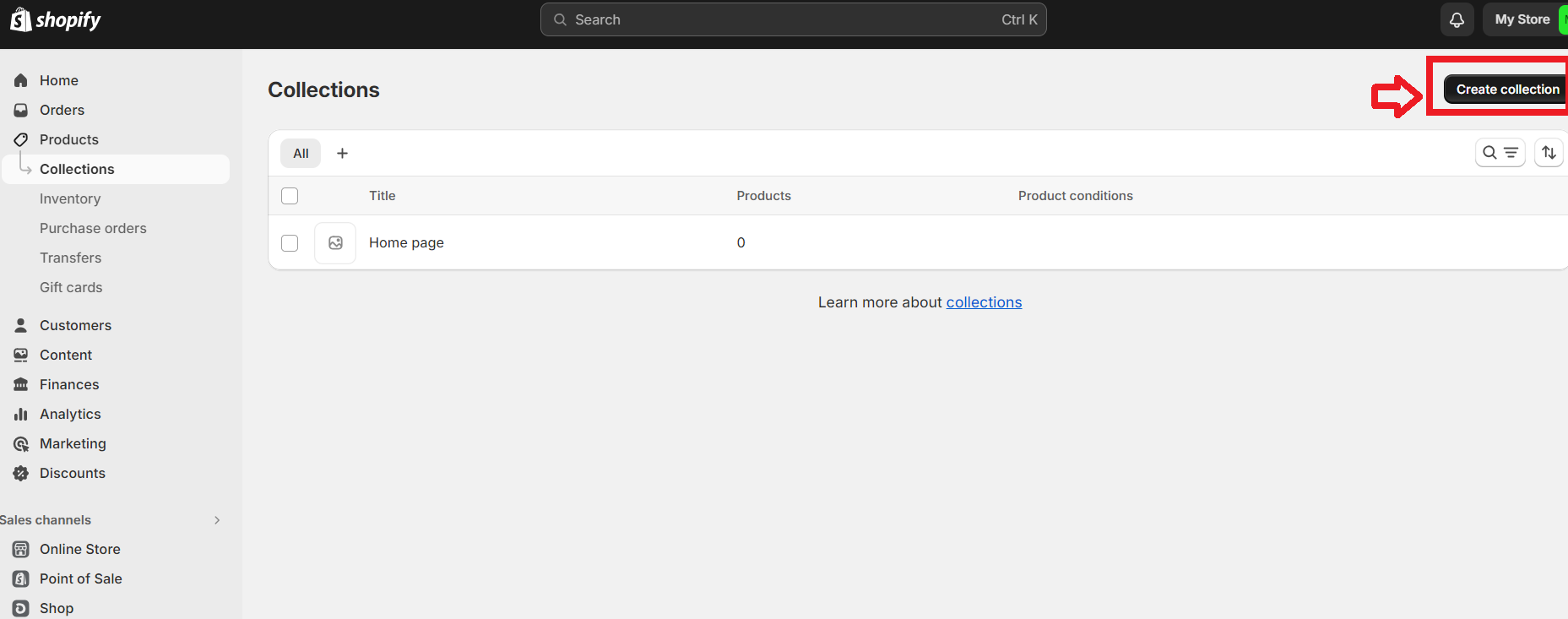
Here, you can add a title and description for the collection dedicated to your first artist and choose Manual under the collection type before saving.
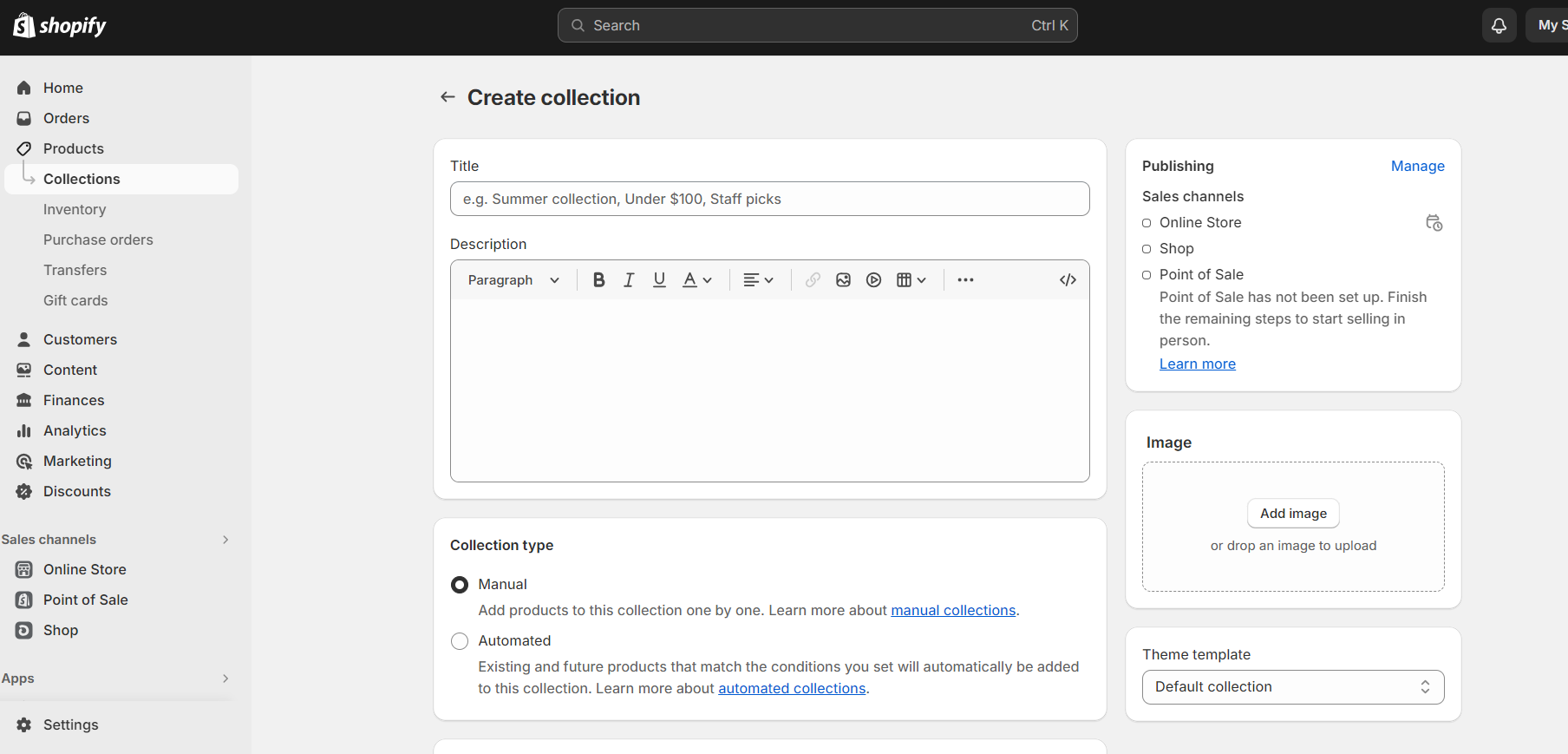
Next, open the collection you just created, and click Browse in the Products card to add merchandise items to this artist’s collection. I
It’s important to include all the items you want available because an artist can only sell items from their specific collection on Spotify.
Then, go back to the Spotify for Artist app within Shopify. Under Artist Accounts, click Connect to pick an artist from your roster.
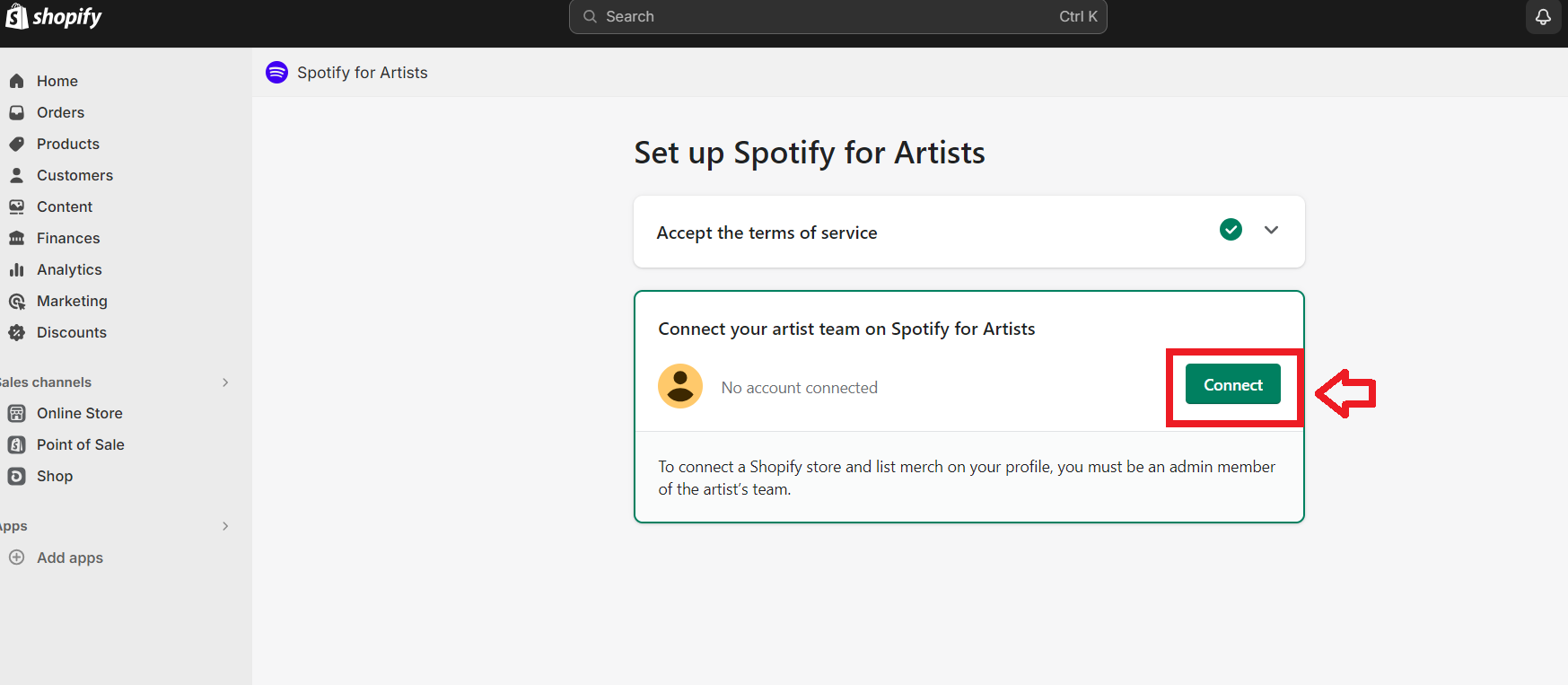
After connecting an artist, click Add Collection and use the search field to locate and select the artist’s merchandise, then confirm by selecting Add Collection.
Repeat these steps for each artist; remember, only the merchandise in the specified collection will be accessible to that artist on Spotify.
Finally, it’s time to make your merchandise available on Spotify. After connecting your accounts and setting up your collections, the products in your Shopify store will automatically be published to your Spotify for Artist account.
However, they won’t be available for sale on Spotify until you complete these setup steps. This process ensures that each artist’s profile displays only their specific merchandise, keeping your offerings organized and targeted.
How Much Does It Cost To Sell On Spotify With Shopify?
When it comes to Sell on Spotify, the app itself does not charge you anything. In fact, there are no listing fees on Spotify at all.
However, if you want to sell products on Spotify, you will probably use their integration with Shopify. Therefore, you will have Shopify subscription costs.
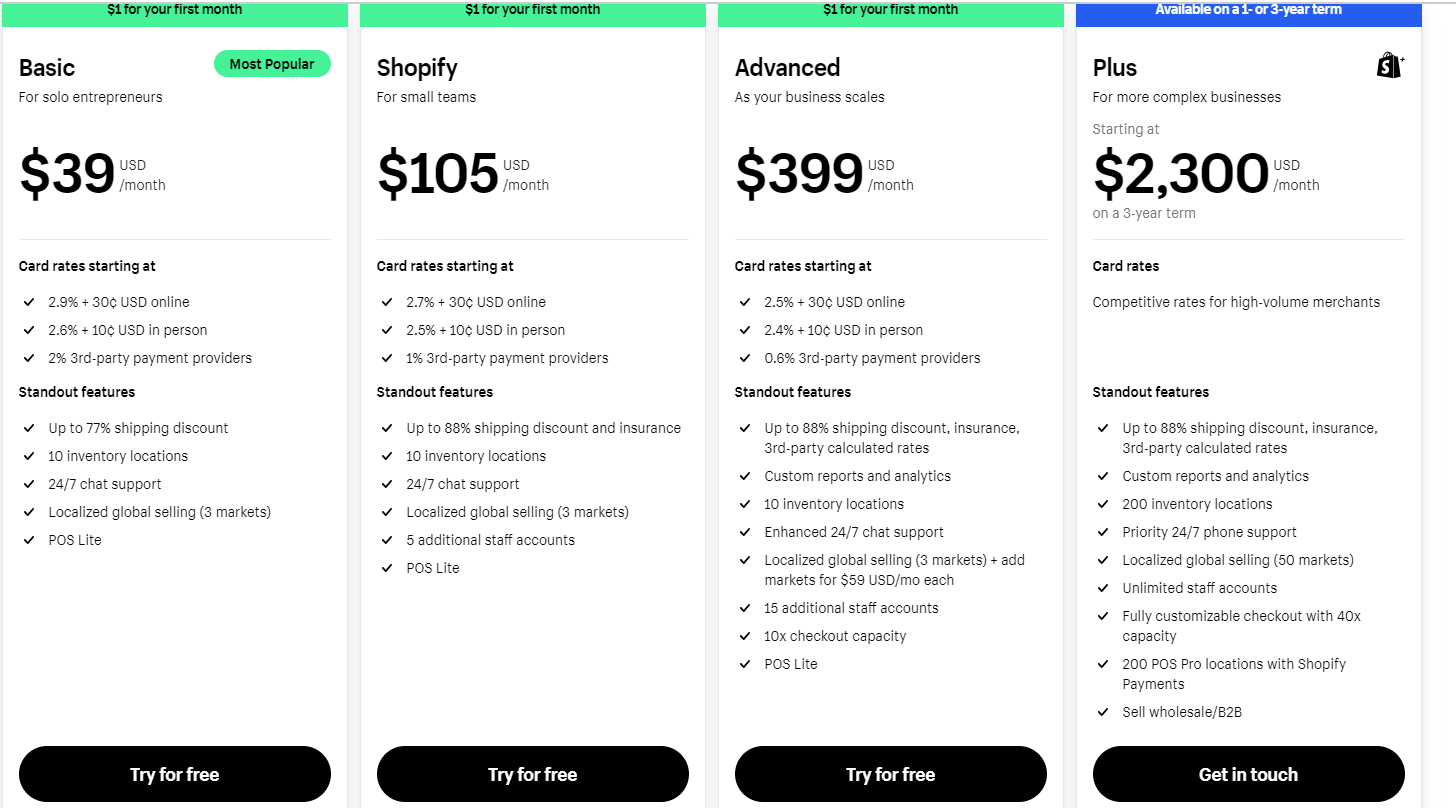
Shopify offers various plans with different features, starting from $39 per month for the “Basic Shopify” plan, which is suitable for new e-commerce businesses.
More advanced plans, like “Shopify” and “Advanced Shopify,” cost $105 and $399 per month, respectively. These plans include additional features such as professional reports, better shipping discounts, and lower transaction fees.
Also, since you need unique designs to sell on Spotify, you will probably use print on demand services. So, for example, Printful charges for each item produced.
The cost varies depending on the product type (e.g., t-shirts, hoodies, mugs, posters) and the printing technique used.
For instance, a basic t-shirt might cost around $10 to $15 to produce, while more premium items or larger products like hoodies might cost more.
What Can You Sell On Spotify?
Now, as I already mentioned, you can sell more than just music or digital products on Spotify. In 2024, this platform will let you sell merchandise as well.
Still, here are the top options that are selling today on Spotify.
Music Streams

Selling music on Spotify is highly beneficial due to its vast global reach, offering you a platform to engage with millions of listeners and earn a steady income from royalties.
So, artists typically receive between $0.003 and $0.005 per stream, which accumulates as fans listen to their tracks.
While royalties depend on agreements with labels, independent artists may retain a larger share.
The platform is especially potent for genres like pop, hip-hop, electronic, and rock, where top tracks often amass millions of streams, making these categories particularly lucrative.
Podcasts

Spotify’s significant investment in podcasts makes it an ideal venue for podcast creators looking to monetize their content.
By hosting your podcasts on Spotify, you can tap into a broad audience, benefiting from the platform’s promotion and visibility.
Podcasts can generate revenue through advertisements and sponsorships, with earnings ranging from $18 to $50 per thousand listens (CPM), depending on your audience size and engagement.
Also, profit margins are favorable, especially for podcasts in popular genres like true crime, news, health, and technology, which attract large, dedicated listener bases.
Merchandise
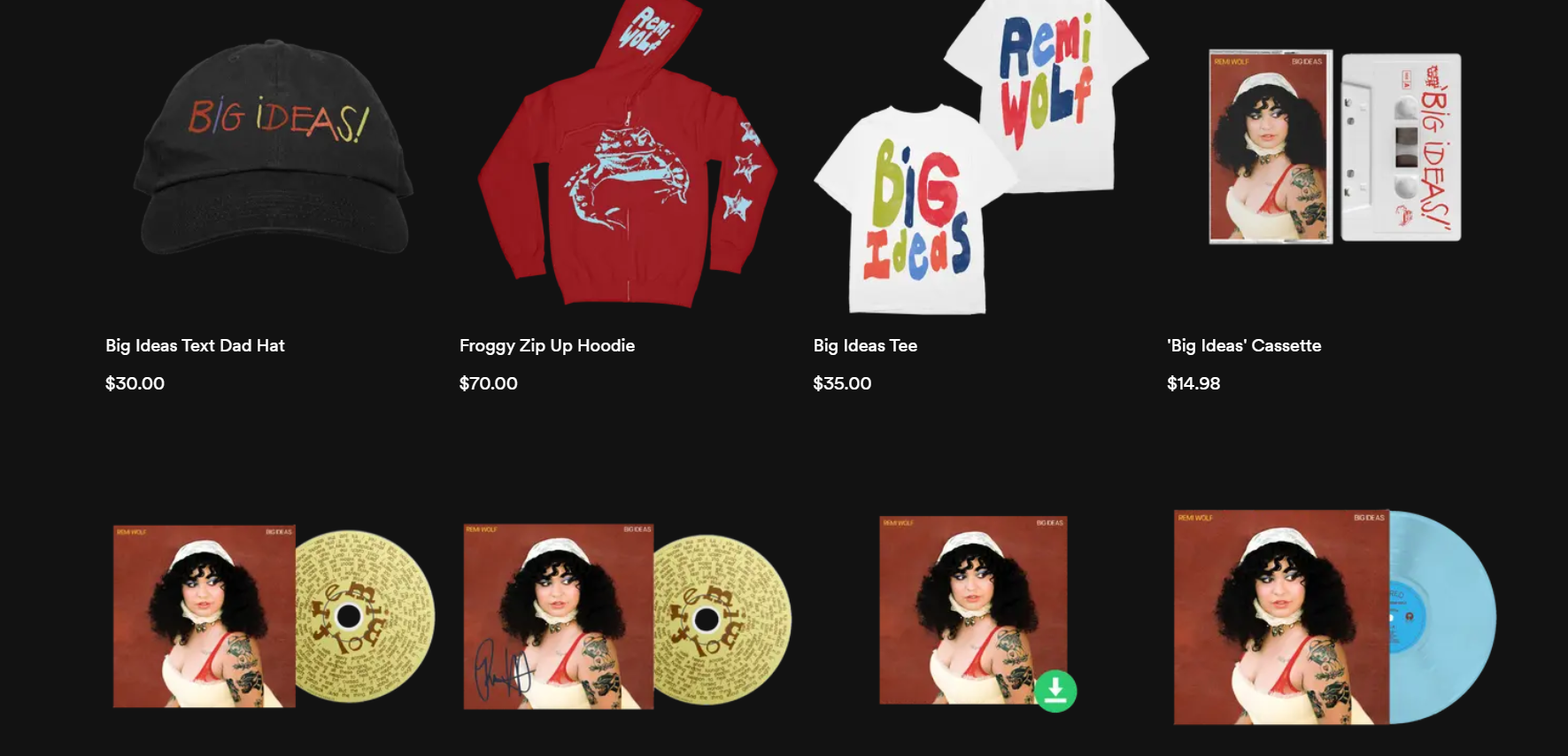
Merchandise sales on Spotify are streamlined through integration with Shopify, allowing artists to directly connect their e-commerce stores to their Spotify profiles.
This setup enables fans to browse and purchase merchandise such as T-shirts, typically priced between $20 to $40.
Also, limited edition items like vinyl, which can range from $25 to $100 or more, right while they listen to the artist’s music.
The profit margins on these items are generally healthy, from 40% to 60%, with exclusive apparel and unique artist-specific items like limited-edition vinyl and signed memorabilia often being best-sellers.
Virtual Events

Virtual events have become a significant part of the Spotify experience, allowing artists to promote ticketed online performances directly to their audience.
Spotify supports these promotions by enabling artists to reach fans who are most likely to be interested, using the platform’s extensive data on listener preferences and behaviors.
Tickets for these events are typically priced from $10 to $50, and their profitability depends largely on the production and hosting costs.
Popular virtual event formats include exclusive live performances, album release parties, and interactive fan experiences, all of which resonate well with the Spotify user base.
Best Merchandise To Sell on Spotify
Exclusive Apparel
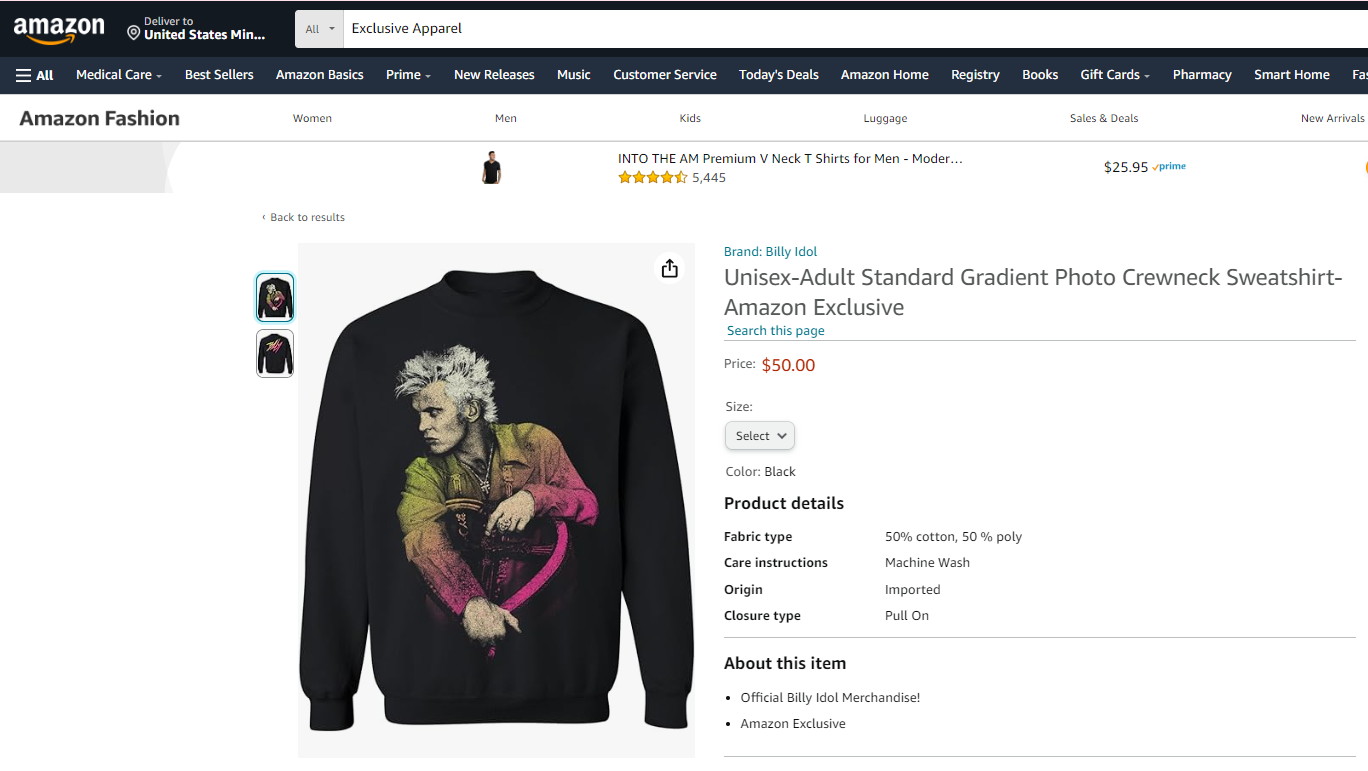
When considering how to sell on Spotify, exclusive apparel like T-shirts and hoodies is a prime category. These items are popular on Spotify, typically priced between $20 to $50.
They offer fans a way to express their musical preferences fashionably and come with significant profit margins of 40% to 70%.
For artists wondering how to sell on Spotify effectively, exclusive or limited edition apparel can command higher prices and margins, making them particularly attractive for fans seeking unique merchandise.
💡 Tip: Learn How to Start a Dropshipping Clothing Business in 2024 [+Suppliers List].
Vinyl Records
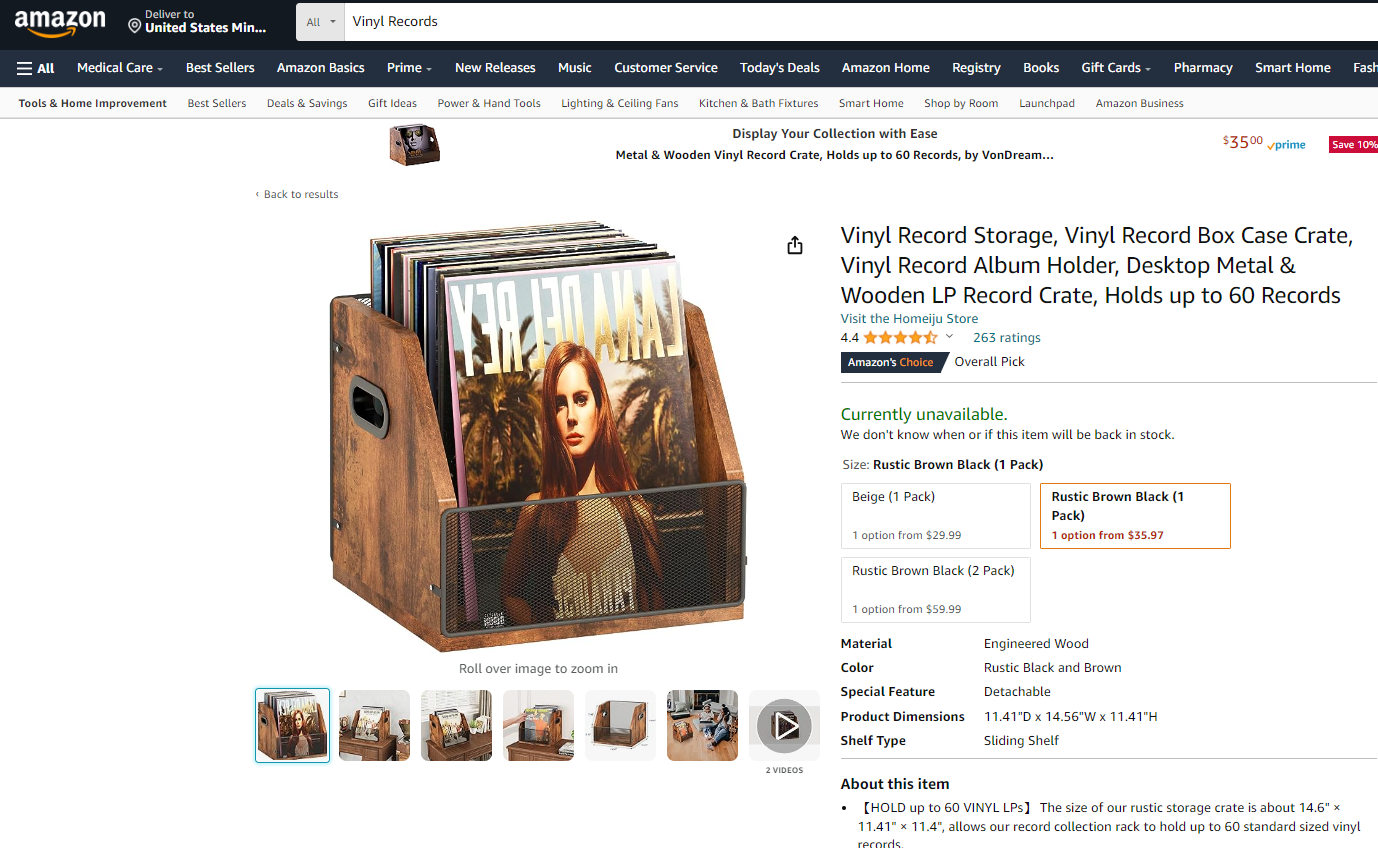
Additionally, for those exploring how to sell on Spotify, Vinyl Records represents a significant opportunity.
Standard editions generally sell for $20 to $40, while limited edition or colored vinyl can range from $25 to $100 or more.
Also, the profit margins for vinyl are strong, about 30% to 50%, with special editions potentially yielding even higher returns due to their collectible nature.
Signed Memorabilia
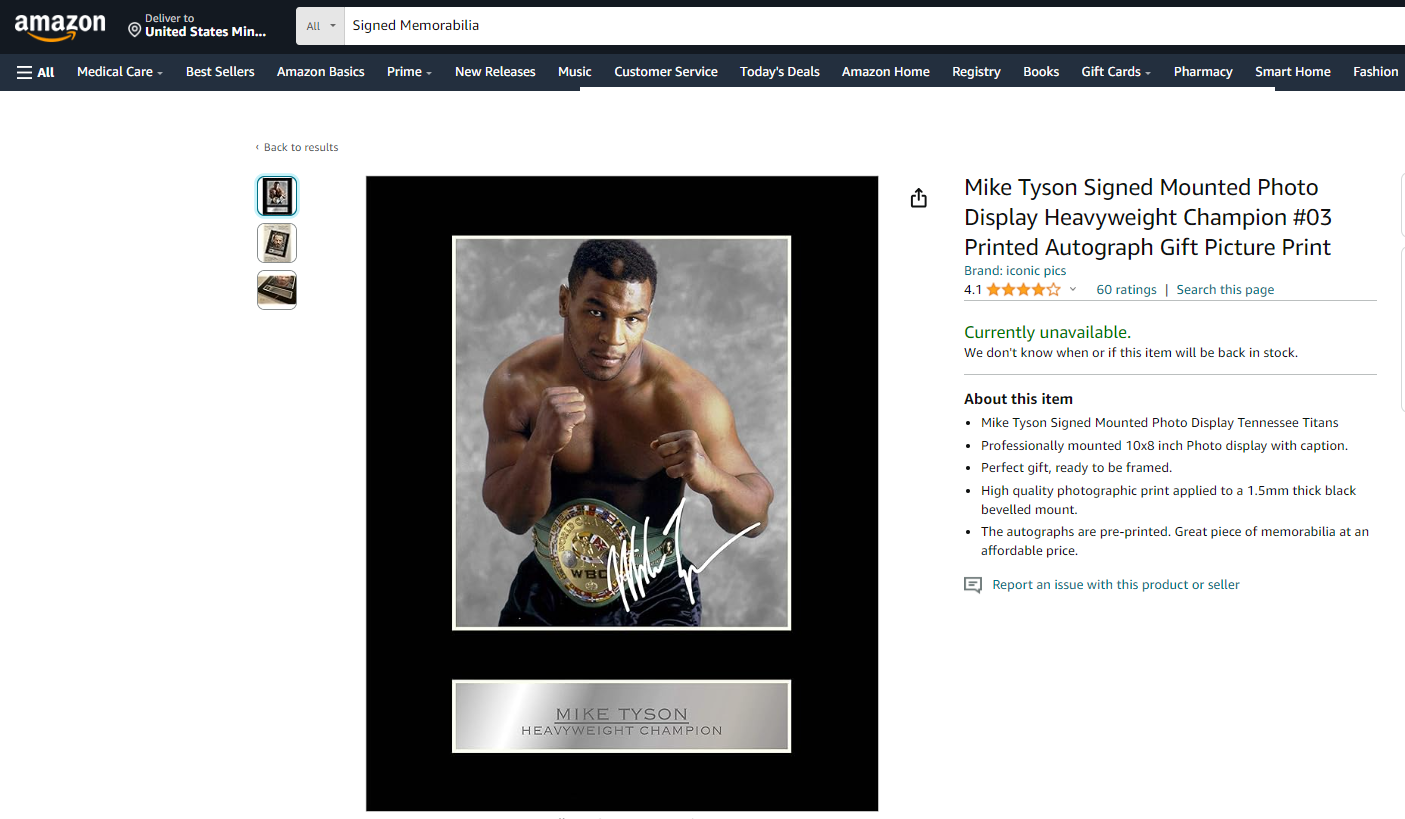
Moreover, Signed Memorabilia provides a personal connection from the artist to the fan, making these items extremely valuable and a great example of how to sell on Spotify.
Prices start at $30 and can escalate significantly, with some items reaching several hundred dollars.
The profit margins for signed items often exceed 70%, as the artist’s signature significantly enhances the value with minimal additional cost, adding a layer of exclusivity.
Special Edition Items
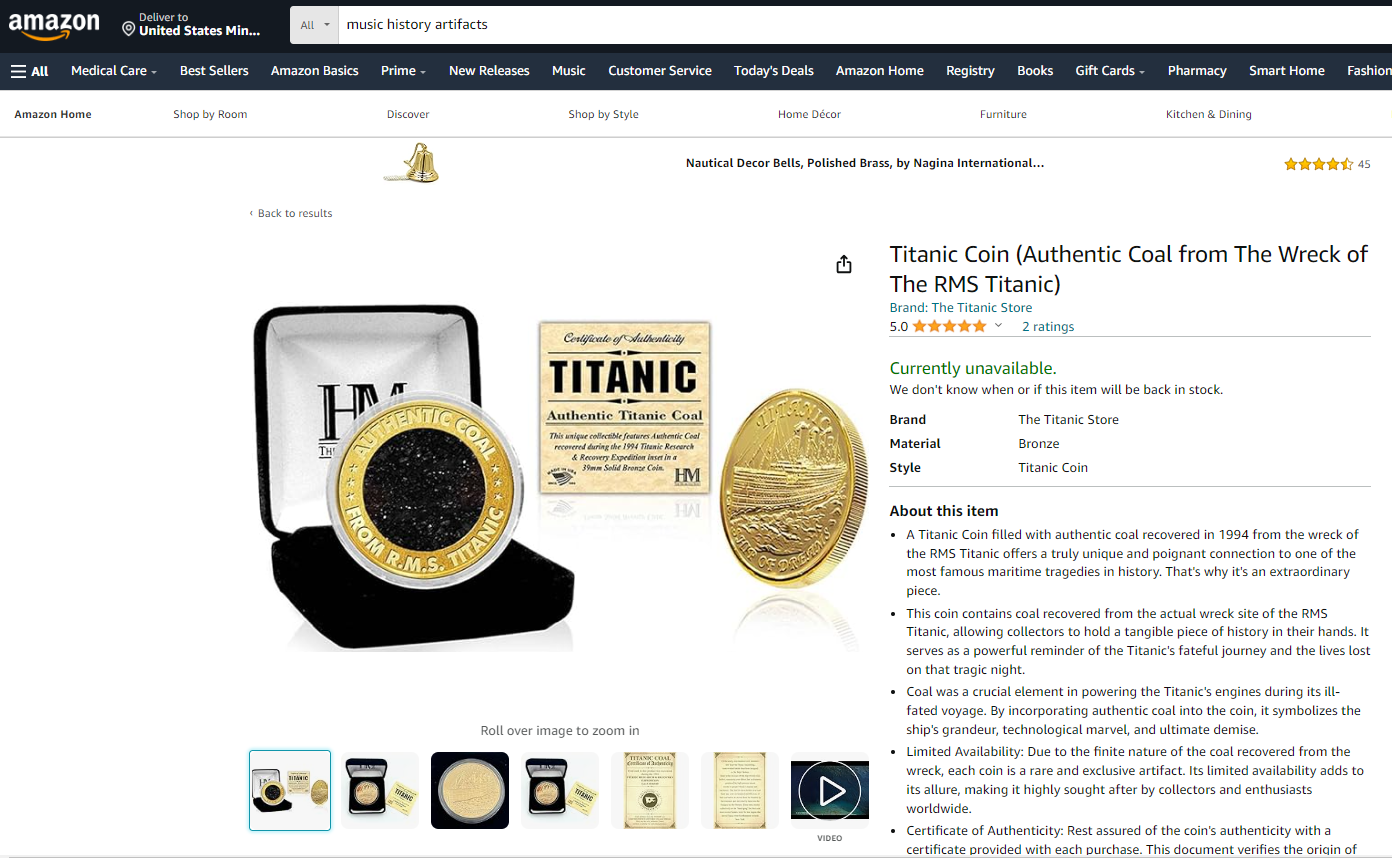
Transitioning to Special Edition Items, this category includes box sets that encompass music, artwork, and band-related artifacts, typically priced between $50 to $200 or more on Spotify.
These items not only offer music but a comprehensive fan experience, featuring profit margins of 40% to 60%.
Their limited availability and unique content make them highly desirable among collectors and loyal fans, illustrating another effective strategy for how to sell on Spotify.
Accessories and Lifestyle Products
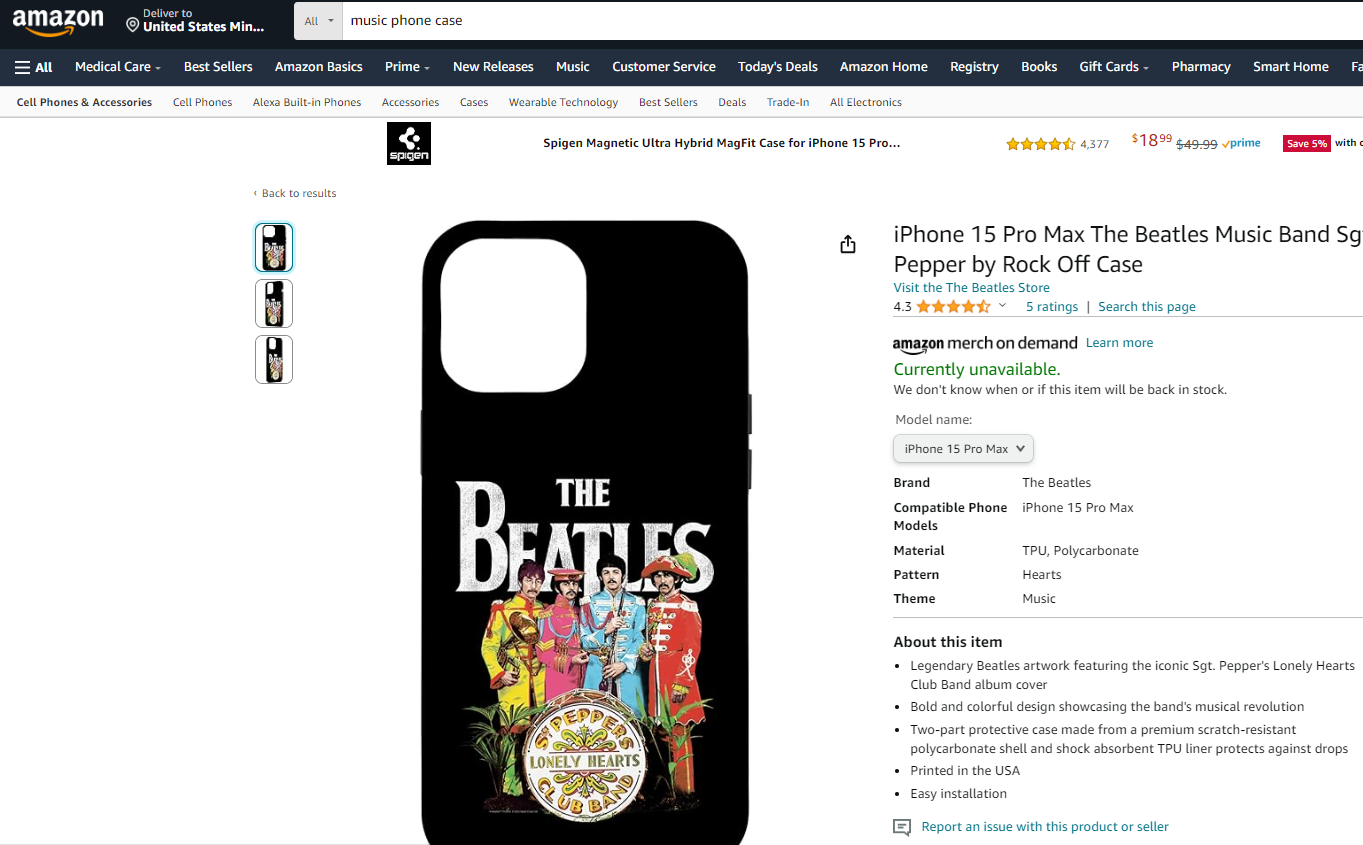
Finally, Accessories and Lifestyle Products complete the merchandise spectrum on Spotify.
Smaller items like phone cases and stickers, priced between $10 to $30, and larger accessories such as bags, which range from $30 to $100, also see substantial sales.
These products typically enjoy high profit margins of 50% to 70%. This is especially true when they are uniquely designed or feature artist branding, enhancing their appeal.
This range effectively shows the breadth of possibilities for artists learning how to sell on Spotify.
Why Sell on Spotify?
Selling merch on Spotify can be worth it, and a profitable venture. So, I personally have several reasons for building this opinion:
✅ Massive User Base
With over 602 million monthly active users, including 236 million paying subscribers, Spotify offers a vast audience for businesses and advertisers.
This diverse user base is spread across various demographics, interests, and regions, providing a ripe environment for targeted marketing and advertising campaigns.
✅ High Engagement
Spotify’s substantial number of monthly active users suggests high engagement levels, with users frequently returning to the platform.
This consistent engagement provides an excellent opportunity for businesses to maintain visibility and relevance among their target audience.
✅ Diverse Content Offering
Spotify hosts more than 100 million tracks and over 5 million podcasts. This diversity in content not only attracts a wide range of listeners but also creates opportunities for niche marketing.
Advertisers can place their ads on specific tracks, genres, or podcasts that align closely with their brand identity or target audience.
✅ Market Dominance
Holding a 31.7% market share in the music streaming industry, Spotify is a leader in its field.
This dominance makes it an attractive platform if you want to sell on Spotify and you are seeking to leverage a well-established and trusted channel to reach consumers.
✅ Revenue Streams
Spotify’s substantial annual revenue, which stood at €13.25 billion in 2023, is indicative of its robust monetization model, which includes both subscription fees and ad-supported streams.
This dual revenue model can benefit advertisers by offering flexible pricing strategies based on different levels of user engagement and ad visibility.
✅ Advanced Targeting and Analytics
Spotify offers sophisticated targeting options that allow advertisers to reach specific demographics based on age, gender, interests, behaviors, and even moments (such as during specific activities like working out or relaxing).
Moreover, Spotify provides detailed analytics that can help advertisers measure the effectiveness of their campaigns and adjust strategies as needed.
✅ Brand Association
Being present on a popular and respected platform like Spotify can enhance brand recognition and association.
As users feel positive about their Spotify experience, this sentiment can extend to the advertisements and brands featured on the platform.


Conclusion
Selling on Spotify via Shopify offers a unique and lucrative opportunity for artists to monetize their presence in a space where their music already lives.
By following the steps outlined in my guide—from setting up a Spotify for Artists account to designing and listing your merchandise with a Shopify integration—you can effectively turn your art into a comprehensive brand experience for your fans.
The key takeaway from this guide is the importance of using both Spotify’s reach and Shopify’s robust e-commerce platform to not only sell merchandise but also enhance fan engagement and create a steady revenue stream.
Also, the best-selling items on Spotify typically include exclusive apparel, vinyl records, and signed memorabilia, which can yield substantial profit margins.
So, is selling merchandise on Spotify a good idea?
In my opinion, selling merchandise on Spotify is a fantastic strategy for artists. It offers the dual benefits of enhancing fan engagement and generating substantial additional income.
However, there are some things you need to consider.
- Audience Engagement: Ensure you have an engaged audience who are likely to purchase merchandise. Your fans’ enthusiasm for your brand is a primary driver of sales.
- Investment in Quality: High-quality, well-designed products are more likely to succeed. Consider the costs of production and design, as these can impact your pricing and profit margins.
- Marketing: Effective promotion of your merchandise on social media and during live events can significantly boost sales. Consider how you will introduce and highlight your merchandise to your audience.













![The Top 21 3PL Companies Compared [2024 List & Guide]](https://images.weserv.nl/?url=https://prod-dropshipping-s3.s3.fr-par.scw.cloud/2024/03/Frame-3922469.jpg&w=420&q=90&output=webp)